Framework for Leading, Managing Sustainable Change in Healthcare
VerifiedAdded on 2023/06/07
|29
|6960
|467
Essay
AI Summary
This essay presents a personal framework for leading, managing, and promoting sustainable change within the healthcare sector, specifically in a theatre nursing environment. It begins with an introduction to the complexities of healthcare organizations and the challenges of implementing change. A critical literature review examines key elements such as strength-based approaches, appreciative inquiry, interpersonal and intrapersonal intelligence, leadership, stakeholder buy-in, and measurement/evaluation. The framework emphasizes the importance of understanding how change happens, gaining stakeholder commitment, and focusing on the strengths of individuals and the organization. It highlights the role of communication, emotional intelligence, and transformational leadership in driving sustainable change. The essay concludes by underscoring the need for continuous monitoring and evaluation to prevent relapse to old practices and ensure the long-term success of change initiatives. This document is available on Desklib, a platform offering a wealth of study resources for students.
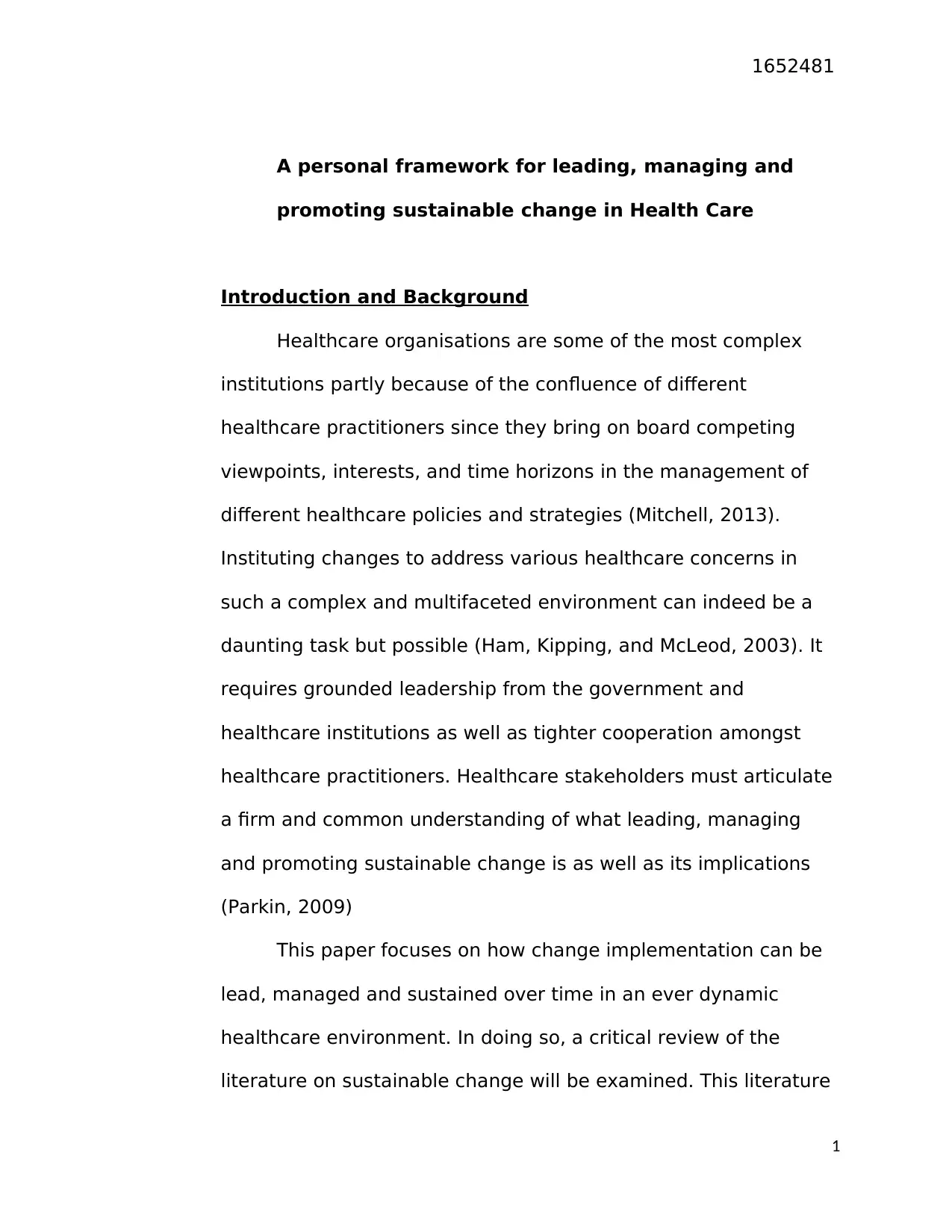
1652481
A personal framework for leading, managing and
promoting sustainable change in Health Care
Introduction and Background
Healthcare organisations are some of the most complex
institutions partly because of the confluence of different
healthcare practitioners since they bring on board competing
viewpoints, interests, and time horizons in the management of
different healthcare policies and strategies (Mitchell, 2013).
Instituting changes to address various healthcare concerns in
such a complex and multifaceted environment can indeed be a
daunting task but possible (Ham, Kipping, and McLeod, 2003). It
requires grounded leadership from the government and
healthcare institutions as well as tighter cooperation amongst
healthcare practitioners. Healthcare stakeholders must articulate
a firm and common understanding of what leading, managing
and promoting sustainable change is as well as its implications
(Parkin, 2009)
This paper focuses on how change implementation can be
lead, managed and sustained over time in an ever dynamic
healthcare environment. In doing so, a critical review of the
literature on sustainable change will be examined. This literature
1
A personal framework for leading, managing and
promoting sustainable change in Health Care
Introduction and Background
Healthcare organisations are some of the most complex
institutions partly because of the confluence of different
healthcare practitioners since they bring on board competing
viewpoints, interests, and time horizons in the management of
different healthcare policies and strategies (Mitchell, 2013).
Instituting changes to address various healthcare concerns in
such a complex and multifaceted environment can indeed be a
daunting task but possible (Ham, Kipping, and McLeod, 2003). It
requires grounded leadership from the government and
healthcare institutions as well as tighter cooperation amongst
healthcare practitioners. Healthcare stakeholders must articulate
a firm and common understanding of what leading, managing
and promoting sustainable change is as well as its implications
(Parkin, 2009)
This paper focuses on how change implementation can be
lead, managed and sustained over time in an ever dynamic
healthcare environment. In doing so, a critical review of the
literature on sustainable change will be examined. This literature
1
Secure Best Marks with AI Grader
Need help grading? Try our AI Grader for instant feedback on your assignments.
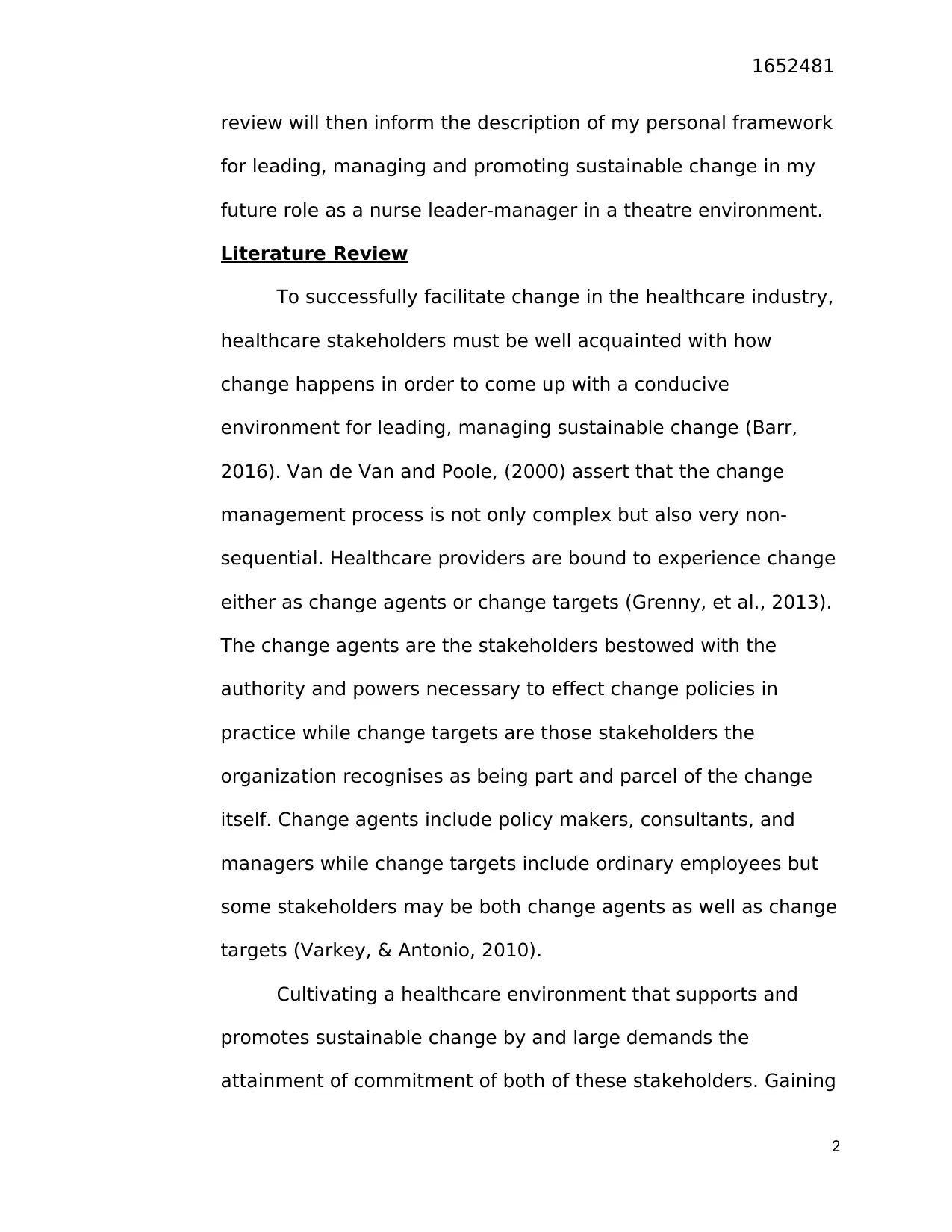
1652481
review will then inform the description of my personal framework
for leading, managing and promoting sustainable change in my
future role as a nurse leader-manager in a theatre environment.
Literature Review
To successfully facilitate change in the healthcare industry,
healthcare stakeholders must be well acquainted with how
change happens in order to come up with a conducive
environment for leading, managing sustainable change (Barr,
2016). Van de Van and Poole, (2000) assert that the change
management process is not only complex but also very non-
sequential. Healthcare providers are bound to experience change
either as change agents or change targets (Grenny, et al., 2013).
The change agents are the stakeholders bestowed with the
authority and powers necessary to effect change policies in
practice while change targets are those stakeholders the
organization recognises as being part and parcel of the change
itself. Change agents include policy makers, consultants, and
managers while change targets include ordinary employees but
some stakeholders may be both change agents as well as change
targets (Varkey, & Antonio, 2010).
Cultivating a healthcare environment that supports and
promotes sustainable change by and large demands the
attainment of commitment of both of these stakeholders. Gaining
2
review will then inform the description of my personal framework
for leading, managing and promoting sustainable change in my
future role as a nurse leader-manager in a theatre environment.
Literature Review
To successfully facilitate change in the healthcare industry,
healthcare stakeholders must be well acquainted with how
change happens in order to come up with a conducive
environment for leading, managing sustainable change (Barr,
2016). Van de Van and Poole, (2000) assert that the change
management process is not only complex but also very non-
sequential. Healthcare providers are bound to experience change
either as change agents or change targets (Grenny, et al., 2013).
The change agents are the stakeholders bestowed with the
authority and powers necessary to effect change policies in
practice while change targets are those stakeholders the
organization recognises as being part and parcel of the change
itself. Change agents include policy makers, consultants, and
managers while change targets include ordinary employees but
some stakeholders may be both change agents as well as change
targets (Varkey, & Antonio, 2010).
Cultivating a healthcare environment that supports and
promotes sustainable change by and large demands the
attainment of commitment of both of these stakeholders. Gaining
2
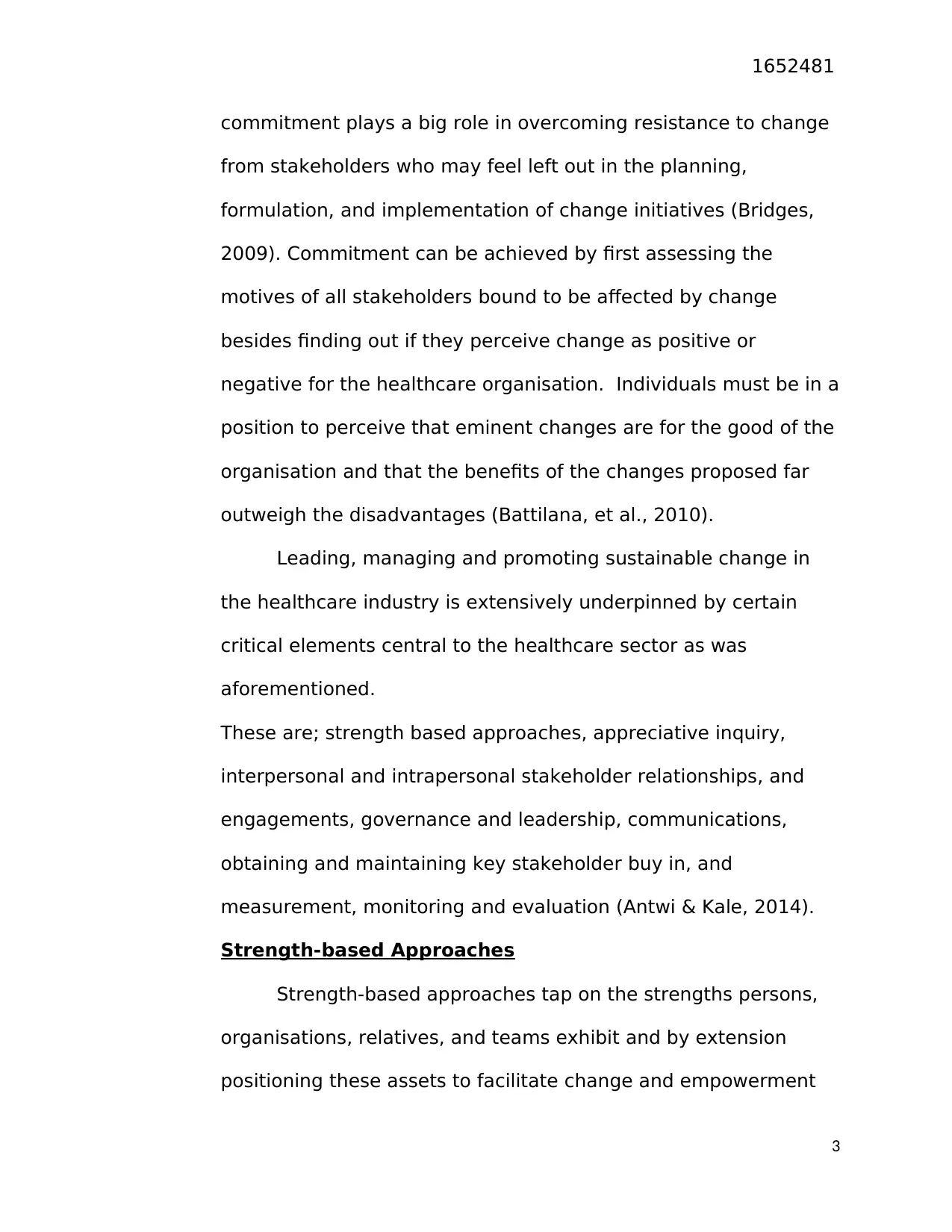
1652481
commitment plays a big role in overcoming resistance to change
from stakeholders who may feel left out in the planning,
formulation, and implementation of change initiatives (Bridges,
2009). Commitment can be achieved by first assessing the
motives of all stakeholders bound to be affected by change
besides finding out if they perceive change as positive or
negative for the healthcare organisation. Individuals must be in a
position to perceive that eminent changes are for the good of the
organisation and that the benefits of the changes proposed far
outweigh the disadvantages (Battilana, et al., 2010).
Leading, managing and promoting sustainable change in
the healthcare industry is extensively underpinned by certain
critical elements central to the healthcare sector as was
aforementioned.
These are; strength based approaches, appreciative inquiry,
interpersonal and intrapersonal stakeholder relationships, and
engagements, governance and leadership, communications,
obtaining and maintaining key stakeholder buy in, and
measurement, monitoring and evaluation (Antwi & Kale, 2014).
Strength-based Approaches
Strength-based approaches tap on the strengths persons,
organisations, relatives, and teams exhibit and by extension
positioning these assets to facilitate change and empowerment
3
commitment plays a big role in overcoming resistance to change
from stakeholders who may feel left out in the planning,
formulation, and implementation of change initiatives (Bridges,
2009). Commitment can be achieved by first assessing the
motives of all stakeholders bound to be affected by change
besides finding out if they perceive change as positive or
negative for the healthcare organisation. Individuals must be in a
position to perceive that eminent changes are for the good of the
organisation and that the benefits of the changes proposed far
outweigh the disadvantages (Battilana, et al., 2010).
Leading, managing and promoting sustainable change in
the healthcare industry is extensively underpinned by certain
critical elements central to the healthcare sector as was
aforementioned.
These are; strength based approaches, appreciative inquiry,
interpersonal and intrapersonal stakeholder relationships, and
engagements, governance and leadership, communications,
obtaining and maintaining key stakeholder buy in, and
measurement, monitoring and evaluation (Antwi & Kale, 2014).
Strength-based Approaches
Strength-based approaches tap on the strengths persons,
organisations, relatives, and teams exhibit and by extension
positioning these assets to facilitate change and empowerment
3
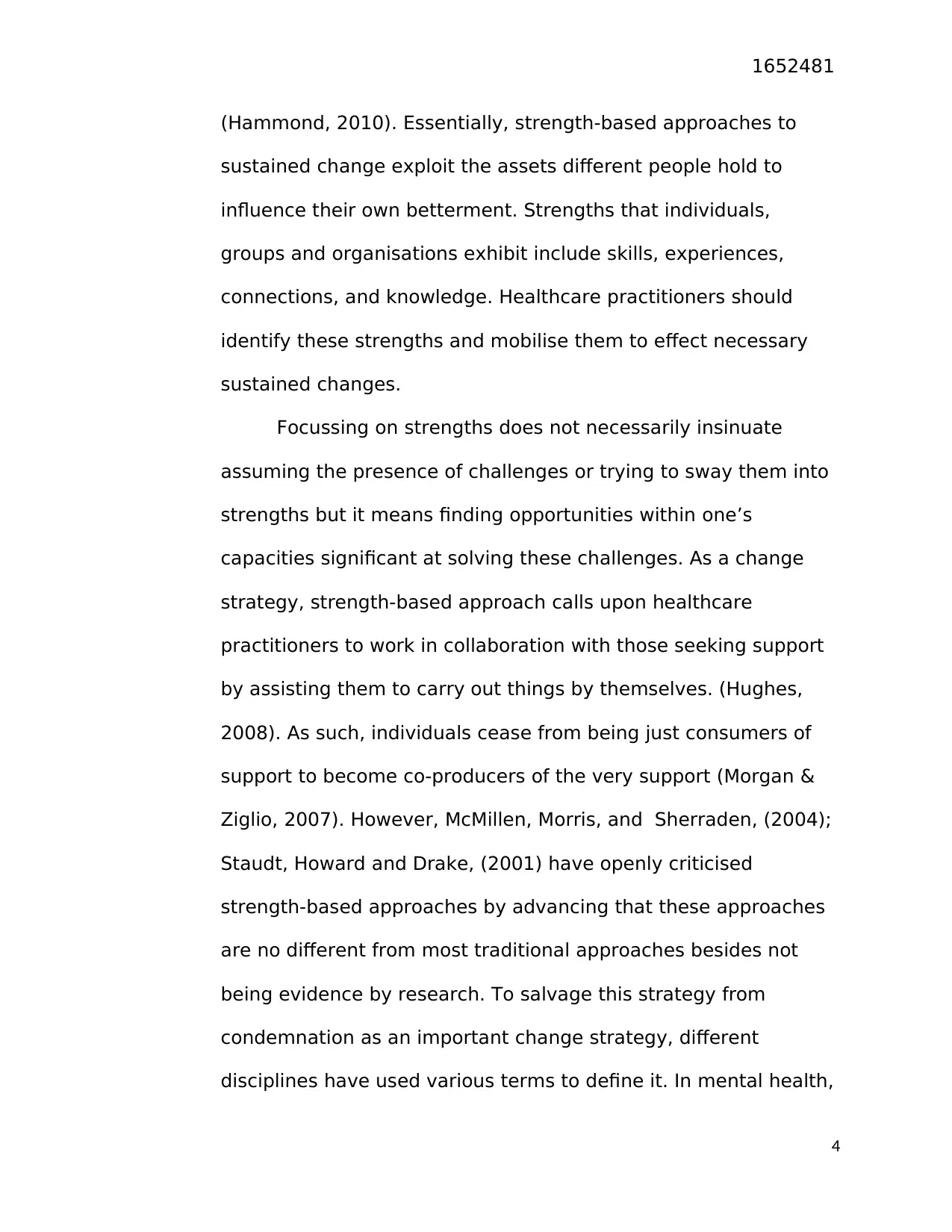
1652481
(Hammond, 2010). Essentially, strength-based approaches to
sustained change exploit the assets different people hold to
influence their own betterment. Strengths that individuals,
groups and organisations exhibit include skills, experiences,
connections, and knowledge. Healthcare practitioners should
identify these strengths and mobilise them to effect necessary
sustained changes.
Focussing on strengths does not necessarily insinuate
assuming the presence of challenges or trying to sway them into
strengths but it means finding opportunities within one’s
capacities significant at solving these challenges. As a change
strategy, strength-based approach calls upon healthcare
practitioners to work in collaboration with those seeking support
by assisting them to carry out things by themselves. (Hughes,
2008). As such, individuals cease from being just consumers of
support to become co-producers of the very support (Morgan &
Ziglio, 2007). However, McMillen, Morris, and Sherraden, (2004);
Staudt, Howard and Drake, (2001) have openly criticised
strength-based approaches by advancing that these approaches
are no different from most traditional approaches besides not
being evidence by research. To salvage this strategy from
condemnation as an important change strategy, different
disciplines have used various terms to define it. In mental health,
4
(Hammond, 2010). Essentially, strength-based approaches to
sustained change exploit the assets different people hold to
influence their own betterment. Strengths that individuals,
groups and organisations exhibit include skills, experiences,
connections, and knowledge. Healthcare practitioners should
identify these strengths and mobilise them to effect necessary
sustained changes.
Focussing on strengths does not necessarily insinuate
assuming the presence of challenges or trying to sway them into
strengths but it means finding opportunities within one’s
capacities significant at solving these challenges. As a change
strategy, strength-based approach calls upon healthcare
practitioners to work in collaboration with those seeking support
by assisting them to carry out things by themselves. (Hughes,
2008). As such, individuals cease from being just consumers of
support to become co-producers of the very support (Morgan &
Ziglio, 2007). However, McMillen, Morris, and Sherraden, (2004);
Staudt, Howard and Drake, (2001) have openly criticised
strength-based approaches by advancing that these approaches
are no different from most traditional approaches besides not
being evidence by research. To salvage this strategy from
condemnation as an important change strategy, different
disciplines have used various terms to define it. In mental health,
4
Secure Best Marks with AI Grader
Need help grading? Try our AI Grader for instant feedback on your assignments.
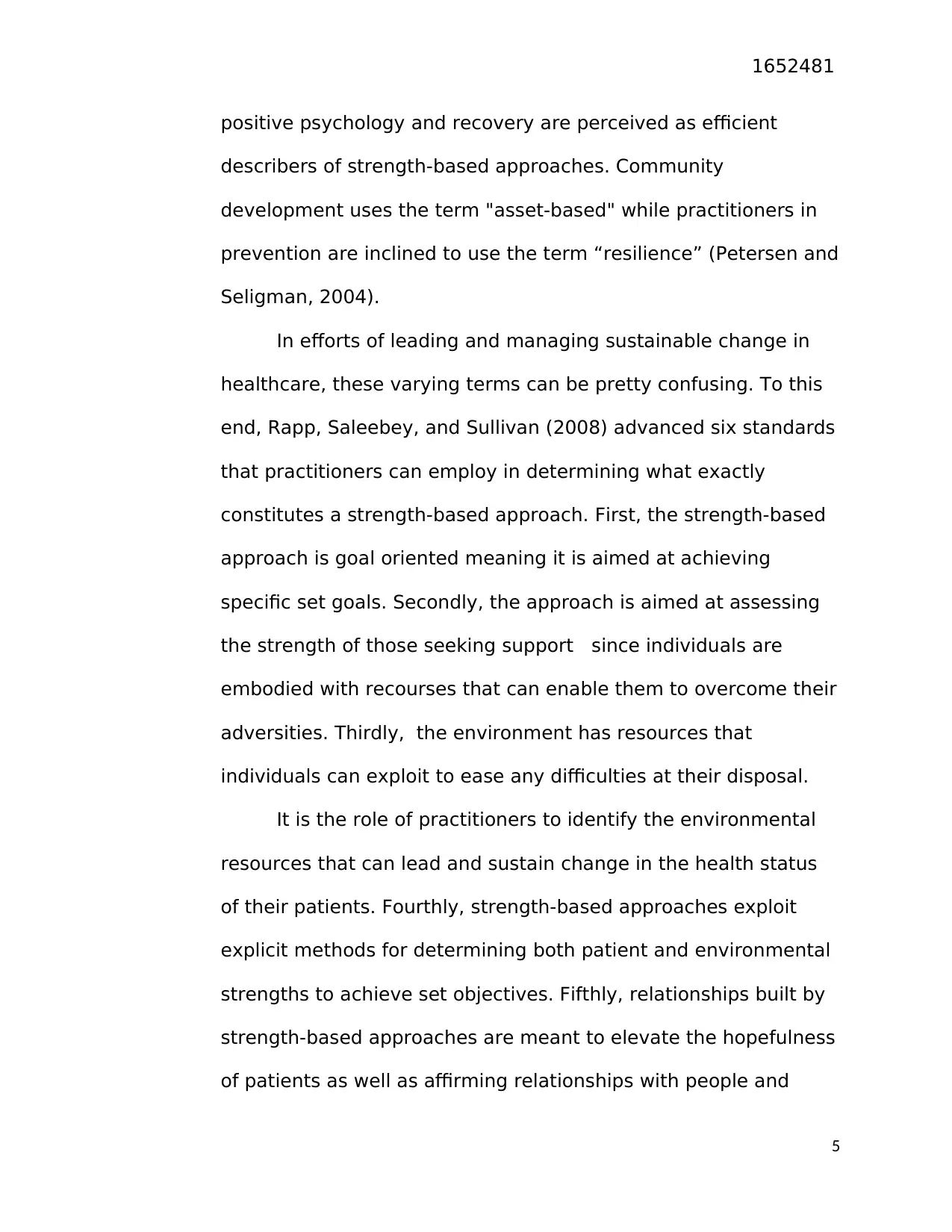
1652481
positive psychology and recovery are perceived as efficient
describers of strength-based approaches. Community
development uses the term "asset-based" while practitioners in
prevention are inclined to use the term “resilience” (Petersen and
Seligman, 2004).
In efforts of leading and managing sustainable change in
healthcare, these varying terms can be pretty confusing. To this
end, Rapp, Saleebey, and Sullivan (2008) advanced six standards
that practitioners can employ in determining what exactly
constitutes a strength-based approach. First, the strength-based
approach is goal oriented meaning it is aimed at achieving
specific set goals. Secondly, the approach is aimed at assessing
the strength of those seeking support since individuals are
embodied with recourses that can enable them to overcome their
adversities. Thirdly, the environment has resources that
individuals can exploit to ease any difficulties at their disposal.
It is the role of practitioners to identify the environmental
resources that can lead and sustain change in the health status
of their patients. Fourthly, strength-based approaches exploit
explicit methods for determining both patient and environmental
strengths to achieve set objectives. Fifthly, relationships built by
strength-based approaches are meant to elevate the hopefulness
of patients as well as affirming relationships with people and
5
positive psychology and recovery are perceived as efficient
describers of strength-based approaches. Community
development uses the term "asset-based" while practitioners in
prevention are inclined to use the term “resilience” (Petersen and
Seligman, 2004).
In efforts of leading and managing sustainable change in
healthcare, these varying terms can be pretty confusing. To this
end, Rapp, Saleebey, and Sullivan (2008) advanced six standards
that practitioners can employ in determining what exactly
constitutes a strength-based approach. First, the strength-based
approach is goal oriented meaning it is aimed at achieving
specific set goals. Secondly, the approach is aimed at assessing
the strength of those seeking support since individuals are
embodied with recourses that can enable them to overcome their
adversities. Thirdly, the environment has resources that
individuals can exploit to ease any difficulties at their disposal.
It is the role of practitioners to identify the environmental
resources that can lead and sustain change in the health status
of their patients. Fourthly, strength-based approaches exploit
explicit methods for determining both patient and environmental
strengths to achieve set objectives. Fifthly, relationships built by
strength-based approaches are meant to elevate the hopefulness
of patients as well as affirming relationships with people and
5
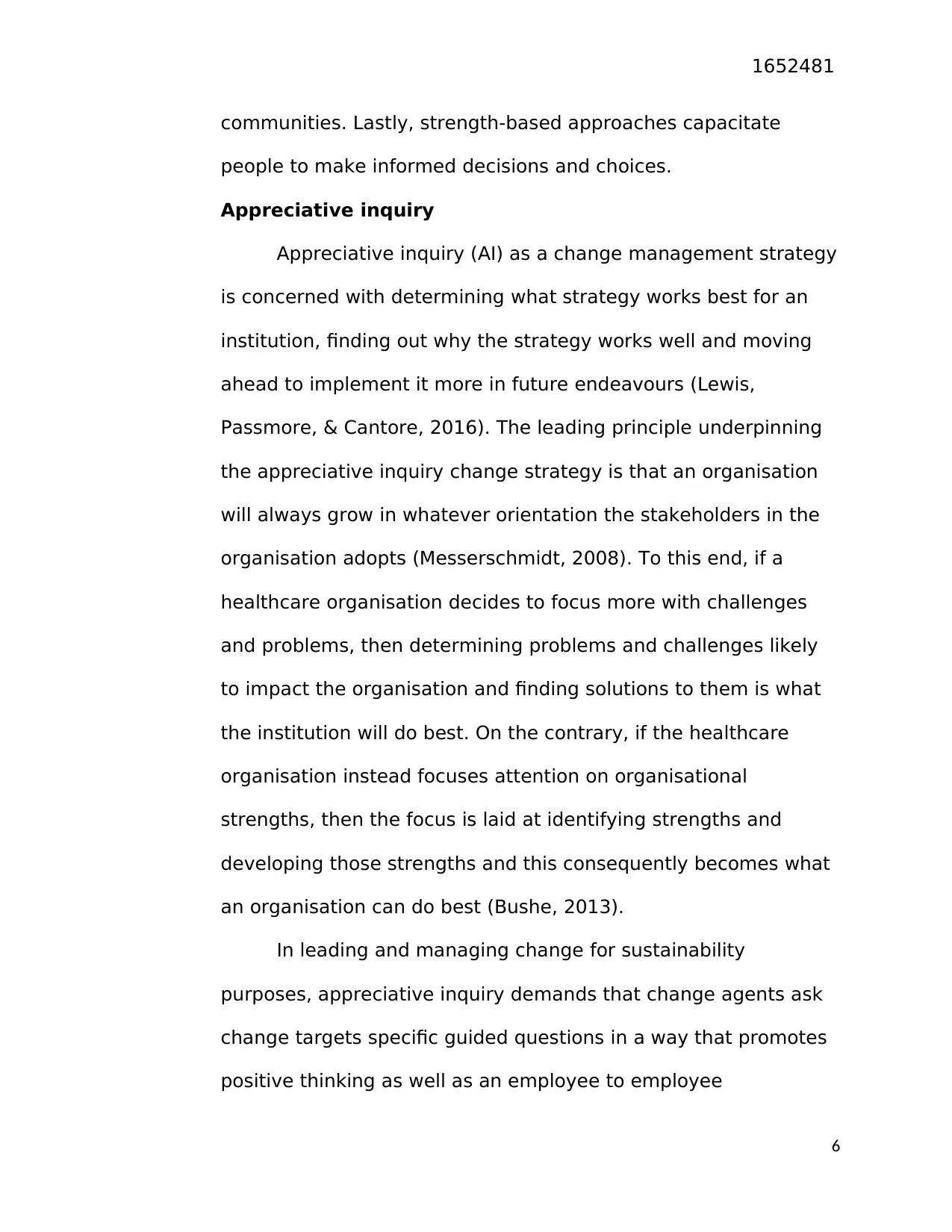
1652481
communities. Lastly, strength-based approaches capacitate
people to make informed decisions and choices.
Appreciative inquiry
Appreciative inquiry (AI) as a change management strategy
is concerned with determining what strategy works best for an
institution, finding out why the strategy works well and moving
ahead to implement it more in future endeavours (Lewis,
Passmore, & Cantore, 2016). The leading principle underpinning
the appreciative inquiry change strategy is that an organisation
will always grow in whatever orientation the stakeholders in the
organisation adopts (Messerschmidt, 2008). To this end, if a
healthcare organisation decides to focus more with challenges
and problems, then determining problems and challenges likely
to impact the organisation and finding solutions to them is what
the institution will do best. On the contrary, if the healthcare
organisation instead focuses attention on organisational
strengths, then the focus is laid at identifying strengths and
developing those strengths and this consequently becomes what
an organisation can do best (Bushe, 2013).
In leading and managing change for sustainability
purposes, appreciative inquiry demands that change agents ask
change targets specific guided questions in a way that promotes
positive thinking as well as an employee to employee
6
communities. Lastly, strength-based approaches capacitate
people to make informed decisions and choices.
Appreciative inquiry
Appreciative inquiry (AI) as a change management strategy
is concerned with determining what strategy works best for an
institution, finding out why the strategy works well and moving
ahead to implement it more in future endeavours (Lewis,
Passmore, & Cantore, 2016). The leading principle underpinning
the appreciative inquiry change strategy is that an organisation
will always grow in whatever orientation the stakeholders in the
organisation adopts (Messerschmidt, 2008). To this end, if a
healthcare organisation decides to focus more with challenges
and problems, then determining problems and challenges likely
to impact the organisation and finding solutions to them is what
the institution will do best. On the contrary, if the healthcare
organisation instead focuses attention on organisational
strengths, then the focus is laid at identifying strengths and
developing those strengths and this consequently becomes what
an organisation can do best (Bushe, 2013).
In leading and managing change for sustainability
purposes, appreciative inquiry demands that change agents ask
change targets specific guided questions in a way that promotes
positive thinking as well as an employee to employee
6
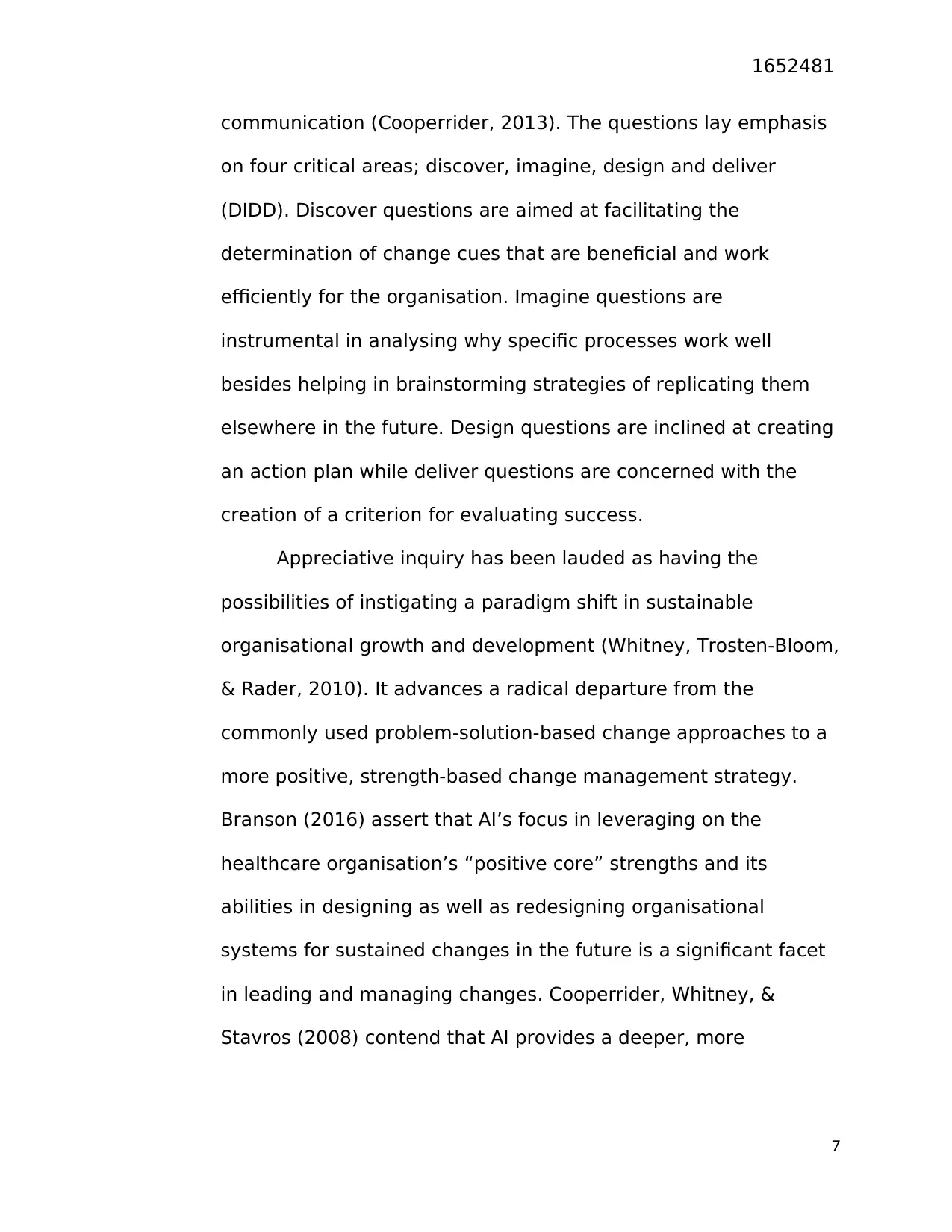
1652481
communication (Cooperrider, 2013). The questions lay emphasis
on four critical areas; discover, imagine, design and deliver
(DIDD). Discover questions are aimed at facilitating the
determination of change cues that are beneficial and work
efficiently for the organisation. Imagine questions are
instrumental in analysing why specific processes work well
besides helping in brainstorming strategies of replicating them
elsewhere in the future. Design questions are inclined at creating
an action plan while deliver questions are concerned with the
creation of a criterion for evaluating success.
Appreciative inquiry has been lauded as having the
possibilities of instigating a paradigm shift in sustainable
organisational growth and development (Whitney, Trosten-Bloom,
& Rader, 2010). It advances a radical departure from the
commonly used problem-solution-based change approaches to a
more positive, strength-based change management strategy.
Branson (2016) assert that AI’s focus in leveraging on the
healthcare organisation’s “positive core” strengths and its
abilities in designing as well as redesigning organisational
systems for sustained changes in the future is a significant facet
in leading and managing changes. Cooperrider, Whitney, &
Stavros (2008) contend that AI provides a deeper, more
7
communication (Cooperrider, 2013). The questions lay emphasis
on four critical areas; discover, imagine, design and deliver
(DIDD). Discover questions are aimed at facilitating the
determination of change cues that are beneficial and work
efficiently for the organisation. Imagine questions are
instrumental in analysing why specific processes work well
besides helping in brainstorming strategies of replicating them
elsewhere in the future. Design questions are inclined at creating
an action plan while deliver questions are concerned with the
creation of a criterion for evaluating success.
Appreciative inquiry has been lauded as having the
possibilities of instigating a paradigm shift in sustainable
organisational growth and development (Whitney, Trosten-Bloom,
& Rader, 2010). It advances a radical departure from the
commonly used problem-solution-based change approaches to a
more positive, strength-based change management strategy.
Branson (2016) assert that AI’s focus in leveraging on the
healthcare organisation’s “positive core” strengths and its
abilities in designing as well as redesigning organisational
systems for sustained changes in the future is a significant facet
in leading and managing changes. Cooperrider, Whitney, &
Stavros (2008) contend that AI provides a deeper, more
7
Paraphrase This Document
Need a fresh take? Get an instant paraphrase of this document with our AI Paraphraser
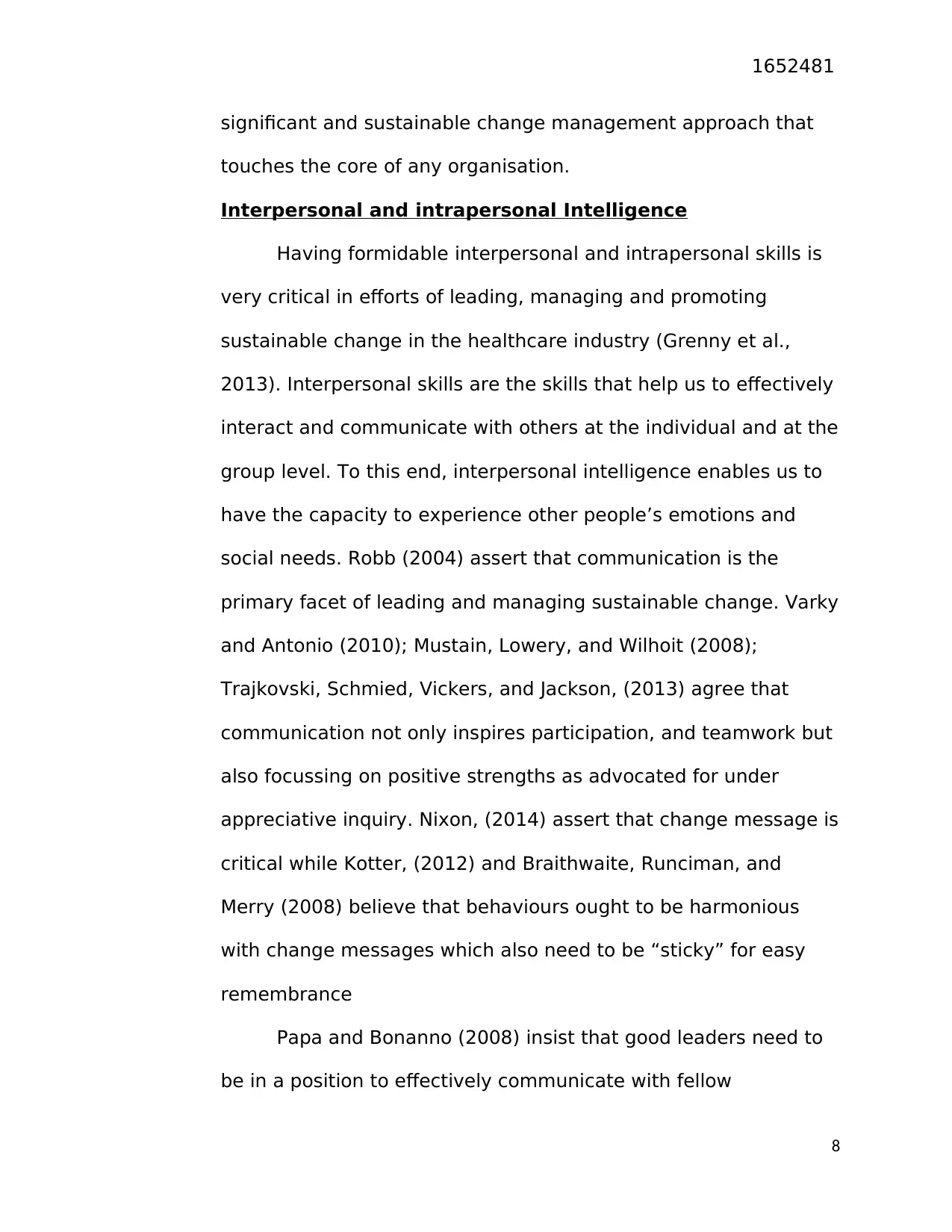
1652481
significant and sustainable change management approach that
touches the core of any organisation.
Interpersonal and intrapersonal Intelligence
Having formidable interpersonal and intrapersonal skills is
very critical in efforts of leading, managing and promoting
sustainable change in the healthcare industry (Grenny et al.,
2013). Interpersonal skills are the skills that help us to effectively
interact and communicate with others at the individual and at the
group level. To this end, interpersonal intelligence enables us to
have the capacity to experience other people’s emotions and
social needs. Robb (2004) assert that communication is the
primary facet of leading and managing sustainable change. Varky
and Antonio (2010); Mustain, Lowery, and Wilhoit (2008);
Trajkovski, Schmied, Vickers, and Jackson, (2013) agree that
communication not only inspires participation, and teamwork but
also focussing on positive strengths as advocated for under
appreciative inquiry. Nixon, (2014) assert that change message is
critical while Kotter, (2012) and Braithwaite, Runciman, and
Merry (2008) believe that behaviours ought to be harmonious
with change messages which also need to be “sticky” for easy
remembrance
Papa and Bonanno (2008) insist that good leaders need to
be in a position to effectively communicate with fellow
8
significant and sustainable change management approach that
touches the core of any organisation.
Interpersonal and intrapersonal Intelligence
Having formidable interpersonal and intrapersonal skills is
very critical in efforts of leading, managing and promoting
sustainable change in the healthcare industry (Grenny et al.,
2013). Interpersonal skills are the skills that help us to effectively
interact and communicate with others at the individual and at the
group level. To this end, interpersonal intelligence enables us to
have the capacity to experience other people’s emotions and
social needs. Robb (2004) assert that communication is the
primary facet of leading and managing sustainable change. Varky
and Antonio (2010); Mustain, Lowery, and Wilhoit (2008);
Trajkovski, Schmied, Vickers, and Jackson, (2013) agree that
communication not only inspires participation, and teamwork but
also focussing on positive strengths as advocated for under
appreciative inquiry. Nixon, (2014) assert that change message is
critical while Kotter, (2012) and Braithwaite, Runciman, and
Merry (2008) believe that behaviours ought to be harmonious
with change messages which also need to be “sticky” for easy
remembrance
Papa and Bonanno (2008) insist that good leaders need to
be in a position to effectively communicate with fellow
8
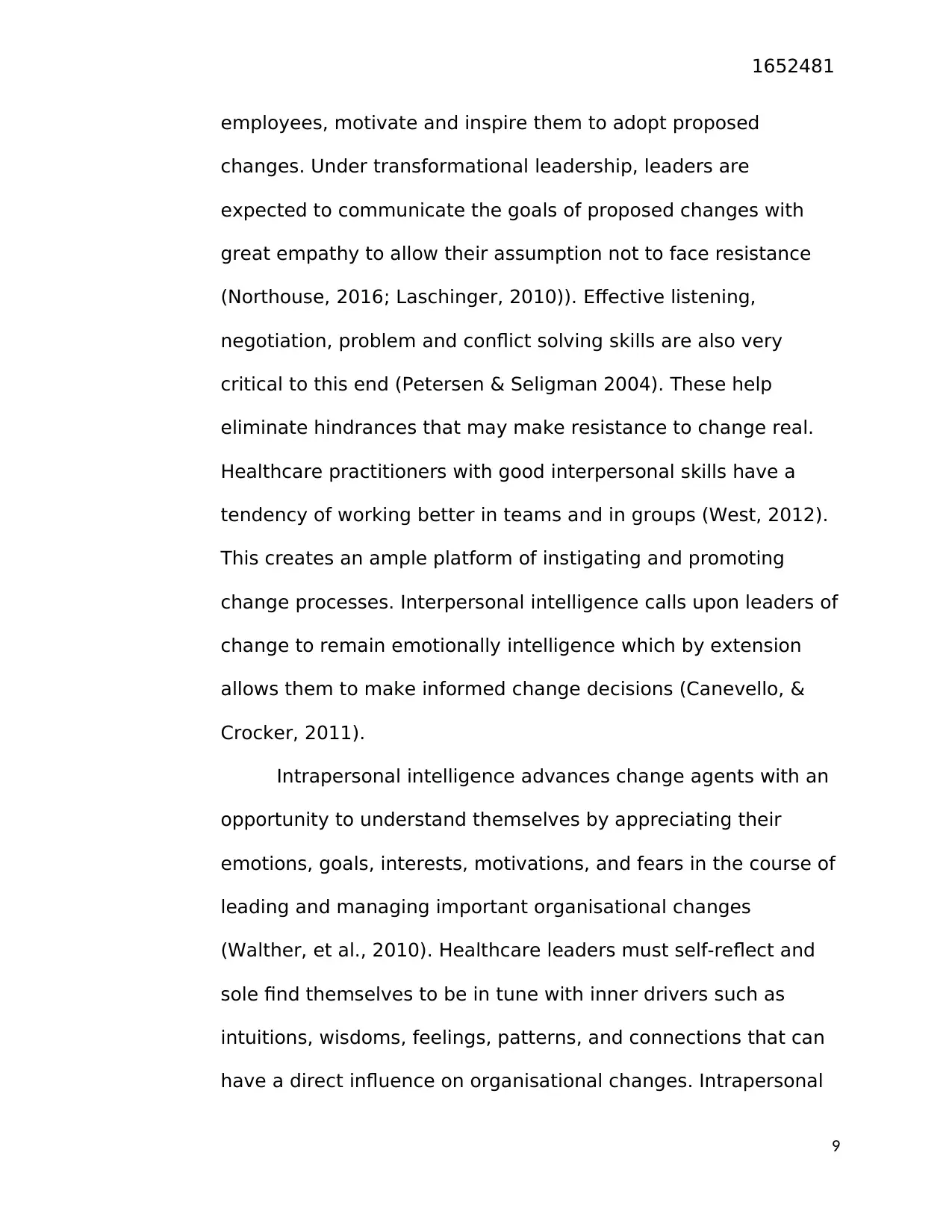
1652481
employees, motivate and inspire them to adopt proposed
changes. Under transformational leadership, leaders are
expected to communicate the goals of proposed changes with
great empathy to allow their assumption not to face resistance
(Northouse, 2016; Laschinger, 2010)). Effective listening,
negotiation, problem and conflict solving skills are also very
critical to this end (Petersen & Seligman 2004). These help
eliminate hindrances that may make resistance to change real.
Healthcare practitioners with good interpersonal skills have a
tendency of working better in teams and in groups (West, 2012).
This creates an ample platform of instigating and promoting
change processes. Interpersonal intelligence calls upon leaders of
change to remain emotionally intelligence which by extension
allows them to make informed change decisions (Canevello, &
Crocker, 2011).
Intrapersonal intelligence advances change agents with an
opportunity to understand themselves by appreciating their
emotions, goals, interests, motivations, and fears in the course of
leading and managing important organisational changes
(Walther, et al., 2010). Healthcare leaders must self-reflect and
sole find themselves to be in tune with inner drivers such as
intuitions, wisdoms, feelings, patterns, and connections that can
have a direct influence on organisational changes. Intrapersonal
9
employees, motivate and inspire them to adopt proposed
changes. Under transformational leadership, leaders are
expected to communicate the goals of proposed changes with
great empathy to allow their assumption not to face resistance
(Northouse, 2016; Laschinger, 2010)). Effective listening,
negotiation, problem and conflict solving skills are also very
critical to this end (Petersen & Seligman 2004). These help
eliminate hindrances that may make resistance to change real.
Healthcare practitioners with good interpersonal skills have a
tendency of working better in teams and in groups (West, 2012).
This creates an ample platform of instigating and promoting
change processes. Interpersonal intelligence calls upon leaders of
change to remain emotionally intelligence which by extension
allows them to make informed change decisions (Canevello, &
Crocker, 2011).
Intrapersonal intelligence advances change agents with an
opportunity to understand themselves by appreciating their
emotions, goals, interests, motivations, and fears in the course of
leading and managing important organisational changes
(Walther, et al., 2010). Healthcare leaders must self-reflect and
sole find themselves to be in tune with inner drivers such as
intuitions, wisdoms, feelings, patterns, and connections that can
have a direct influence on organisational changes. Intrapersonal
9
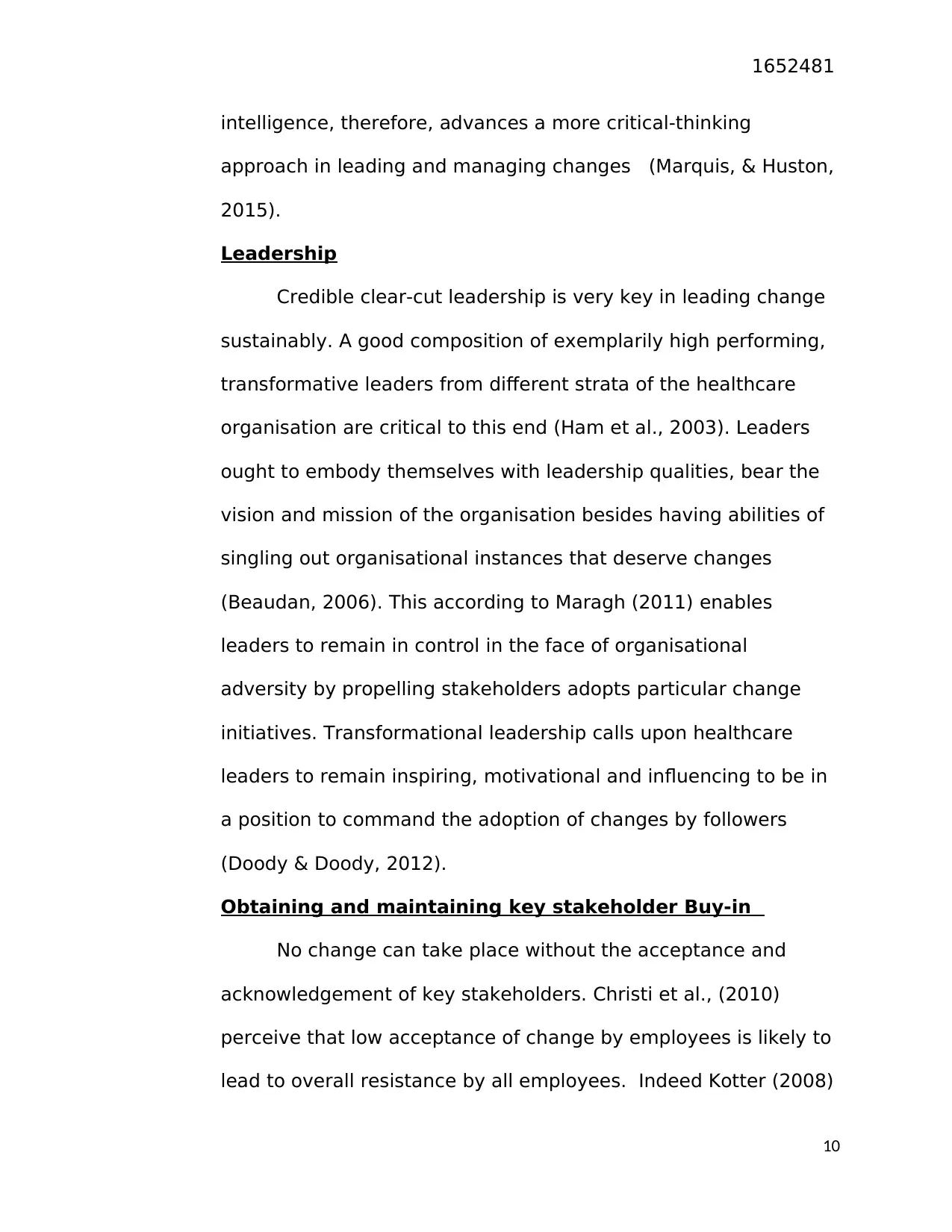
1652481
intelligence, therefore, advances a more critical-thinking
approach in leading and managing changes (Marquis, & Huston,
2015).
Leadership
Credible clear-cut leadership is very key in leading change
sustainably. A good composition of exemplarily high performing,
transformative leaders from different strata of the healthcare
organisation are critical to this end (Ham et al., 2003). Leaders
ought to embody themselves with leadership qualities, bear the
vision and mission of the organisation besides having abilities of
singling out organisational instances that deserve changes
(Beaudan, 2006). This according to Maragh (2011) enables
leaders to remain in control in the face of organisational
adversity by propelling stakeholders adopts particular change
initiatives. Transformational leadership calls upon healthcare
leaders to remain inspiring, motivational and influencing to be in
a position to command the adoption of changes by followers
(Doody & Doody, 2012).
Obtaining and maintaining key stakeholder Buy-in
No change can take place without the acceptance and
acknowledgement of key stakeholders. Christi et al., (2010)
perceive that low acceptance of change by employees is likely to
lead to overall resistance by all employees. Indeed Kotter (2008)
10
intelligence, therefore, advances a more critical-thinking
approach in leading and managing changes (Marquis, & Huston,
2015).
Leadership
Credible clear-cut leadership is very key in leading change
sustainably. A good composition of exemplarily high performing,
transformative leaders from different strata of the healthcare
organisation are critical to this end (Ham et al., 2003). Leaders
ought to embody themselves with leadership qualities, bear the
vision and mission of the organisation besides having abilities of
singling out organisational instances that deserve changes
(Beaudan, 2006). This according to Maragh (2011) enables
leaders to remain in control in the face of organisational
adversity by propelling stakeholders adopts particular change
initiatives. Transformational leadership calls upon healthcare
leaders to remain inspiring, motivational and influencing to be in
a position to command the adoption of changes by followers
(Doody & Doody, 2012).
Obtaining and maintaining key stakeholder Buy-in
No change can take place without the acceptance and
acknowledgement of key stakeholders. Christi et al., (2010)
perceive that low acceptance of change by employees is likely to
lead to overall resistance by all employees. Indeed Kotter (2008)
10
Secure Best Marks with AI Grader
Need help grading? Try our AI Grader for instant feedback on your assignments.
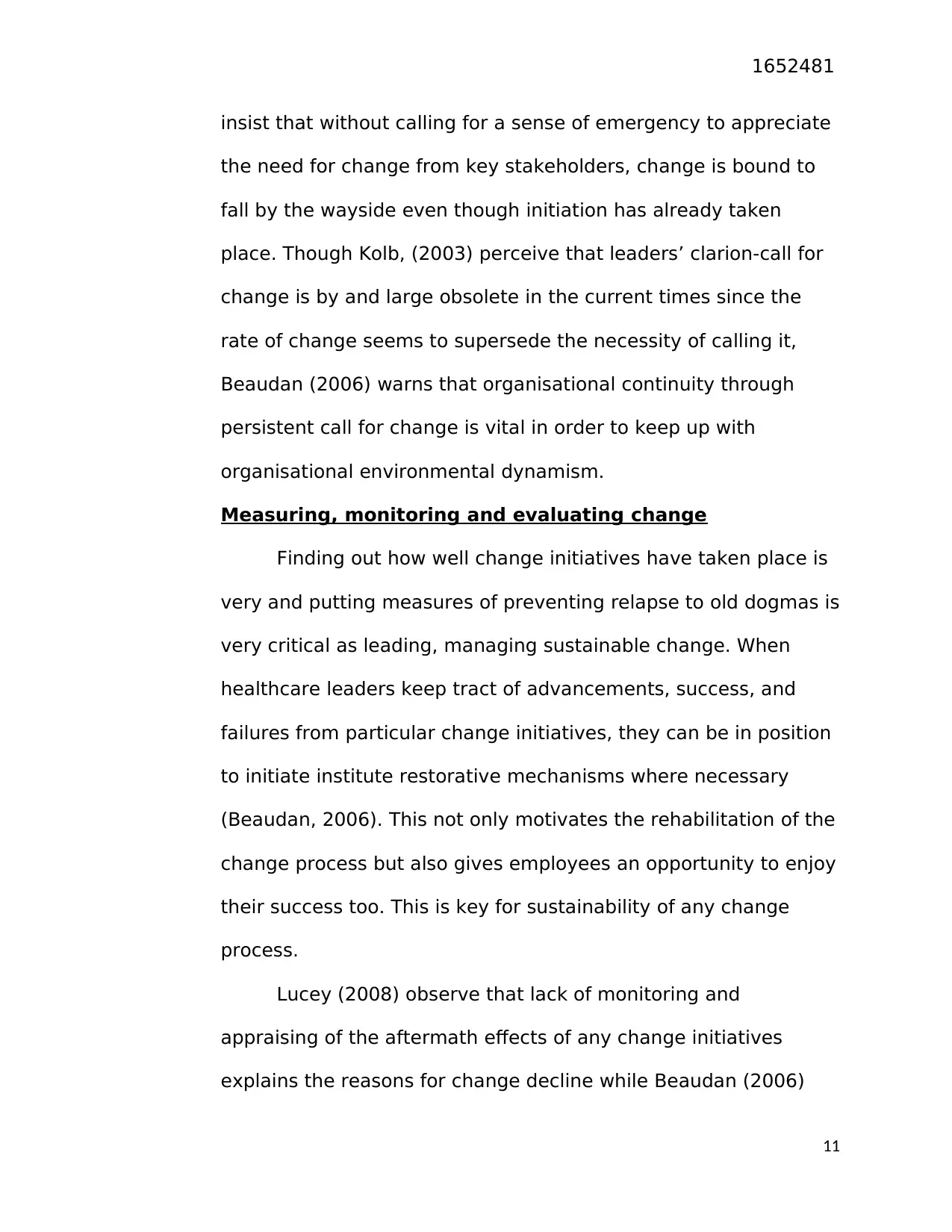
1652481
insist that without calling for a sense of emergency to appreciate
the need for change from key stakeholders, change is bound to
fall by the wayside even though initiation has already taken
place. Though Kolb, (2003) perceive that leaders’ clarion-call for
change is by and large obsolete in the current times since the
rate of change seems to supersede the necessity of calling it,
Beaudan (2006) warns that organisational continuity through
persistent call for change is vital in order to keep up with
organisational environmental dynamism.
Measuring, monitoring and evaluating change
Finding out how well change initiatives have taken place is
very and putting measures of preventing relapse to old dogmas is
very critical as leading, managing sustainable change. When
healthcare leaders keep tract of advancements, success, and
failures from particular change initiatives, they can be in position
to initiate institute restorative mechanisms where necessary
(Beaudan, 2006). This not only motivates the rehabilitation of the
change process but also gives employees an opportunity to enjoy
their success too. This is key for sustainability of any change
process.
Lucey (2008) observe that lack of monitoring and
appraising of the aftermath effects of any change initiatives
explains the reasons for change decline while Beaudan (2006)
11
insist that without calling for a sense of emergency to appreciate
the need for change from key stakeholders, change is bound to
fall by the wayside even though initiation has already taken
place. Though Kolb, (2003) perceive that leaders’ clarion-call for
change is by and large obsolete in the current times since the
rate of change seems to supersede the necessity of calling it,
Beaudan (2006) warns that organisational continuity through
persistent call for change is vital in order to keep up with
organisational environmental dynamism.
Measuring, monitoring and evaluating change
Finding out how well change initiatives have taken place is
very and putting measures of preventing relapse to old dogmas is
very critical as leading, managing sustainable change. When
healthcare leaders keep tract of advancements, success, and
failures from particular change initiatives, they can be in position
to initiate institute restorative mechanisms where necessary
(Beaudan, 2006). This not only motivates the rehabilitation of the
change process but also gives employees an opportunity to enjoy
their success too. This is key for sustainability of any change
process.
Lucey (2008) observe that lack of monitoring and
appraising of the aftermath effects of any change initiatives
explains the reasons for change decline while Beaudan (2006)
11
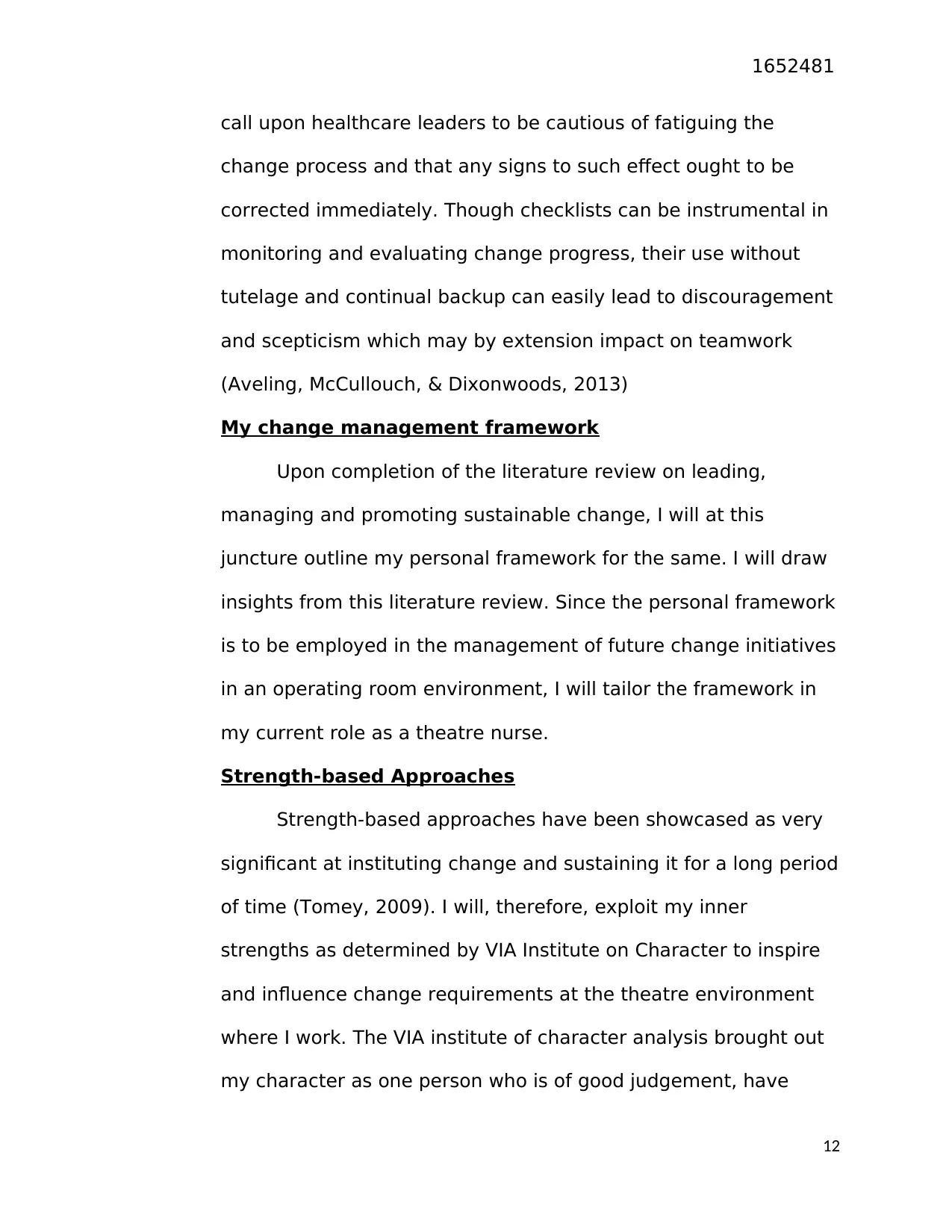
1652481
call upon healthcare leaders to be cautious of fatiguing the
change process and that any signs to such effect ought to be
corrected immediately. Though checklists can be instrumental in
monitoring and evaluating change progress, their use without
tutelage and continual backup can easily lead to discouragement
and scepticism which may by extension impact on teamwork
(Aveling, McCullouch, & Dixonwoods, 2013)
My change management framework
Upon completion of the literature review on leading,
managing and promoting sustainable change, I will at this
juncture outline my personal framework for the same. I will draw
insights from this literature review. Since the personal framework
is to be employed in the management of future change initiatives
in an operating room environment, I will tailor the framework in
my current role as a theatre nurse.
Strength-based Approaches
Strength-based approaches have been showcased as very
significant at instituting change and sustaining it for a long period
of time (Tomey, 2009). I will, therefore, exploit my inner
strengths as determined by VIA Institute on Character to inspire
and influence change requirements at the theatre environment
where I work. The VIA institute of character analysis brought out
my character as one person who is of good judgement, have
12
call upon healthcare leaders to be cautious of fatiguing the
change process and that any signs to such effect ought to be
corrected immediately. Though checklists can be instrumental in
monitoring and evaluating change progress, their use without
tutelage and continual backup can easily lead to discouragement
and scepticism which may by extension impact on teamwork
(Aveling, McCullouch, & Dixonwoods, 2013)
My change management framework
Upon completion of the literature review on leading,
managing and promoting sustainable change, I will at this
juncture outline my personal framework for the same. I will draw
insights from this literature review. Since the personal framework
is to be employed in the management of future change initiatives
in an operating room environment, I will tailor the framework in
my current role as a theatre nurse.
Strength-based Approaches
Strength-based approaches have been showcased as very
significant at instituting change and sustaining it for a long period
of time (Tomey, 2009). I will, therefore, exploit my inner
strengths as determined by VIA Institute on Character to inspire
and influence change requirements at the theatre environment
where I work. The VIA institute of character analysis brought out
my character as one person who is of good judgement, have
12
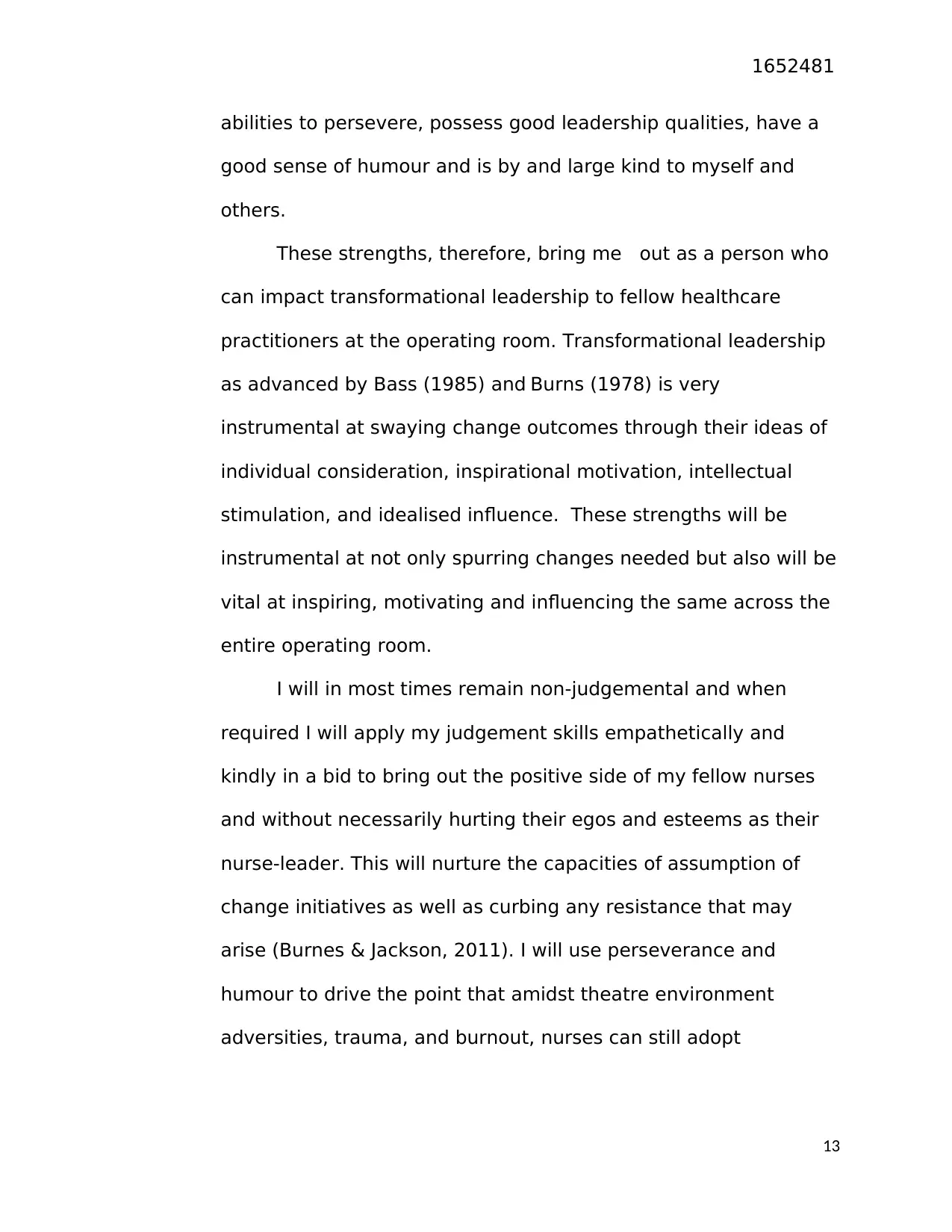
1652481
abilities to persevere, possess good leadership qualities, have a
good sense of humour and is by and large kind to myself and
others.
These strengths, therefore, bring me out as a person who
can impact transformational leadership to fellow healthcare
practitioners at the operating room. Transformational leadership
as advanced by Bass (1985) and Burns (1978) is very
instrumental at swaying change outcomes through their ideas of
individual consideration, inspirational motivation, intellectual
stimulation, and idealised influence. These strengths will be
instrumental at not only spurring changes needed but also will be
vital at inspiring, motivating and influencing the same across the
entire operating room.
I will in most times remain non-judgemental and when
required I will apply my judgement skills empathetically and
kindly in a bid to bring out the positive side of my fellow nurses
and without necessarily hurting their egos and esteems as their
nurse-leader. This will nurture the capacities of assumption of
change initiatives as well as curbing any resistance that may
arise (Burnes & Jackson, 2011). I will use perseverance and
humour to drive the point that amidst theatre environment
adversities, trauma, and burnout, nurses can still adopt
13
abilities to persevere, possess good leadership qualities, have a
good sense of humour and is by and large kind to myself and
others.
These strengths, therefore, bring me out as a person who
can impact transformational leadership to fellow healthcare
practitioners at the operating room. Transformational leadership
as advanced by Bass (1985) and Burns (1978) is very
instrumental at swaying change outcomes through their ideas of
individual consideration, inspirational motivation, intellectual
stimulation, and idealised influence. These strengths will be
instrumental at not only spurring changes needed but also will be
vital at inspiring, motivating and influencing the same across the
entire operating room.
I will in most times remain non-judgemental and when
required I will apply my judgement skills empathetically and
kindly in a bid to bring out the positive side of my fellow nurses
and without necessarily hurting their egos and esteems as their
nurse-leader. This will nurture the capacities of assumption of
change initiatives as well as curbing any resistance that may
arise (Burnes & Jackson, 2011). I will use perseverance and
humour to drive the point that amidst theatre environment
adversities, trauma, and burnout, nurses can still adopt
13
Paraphrase This Document
Need a fresh take? Get an instant paraphrase of this document with our AI Paraphraser
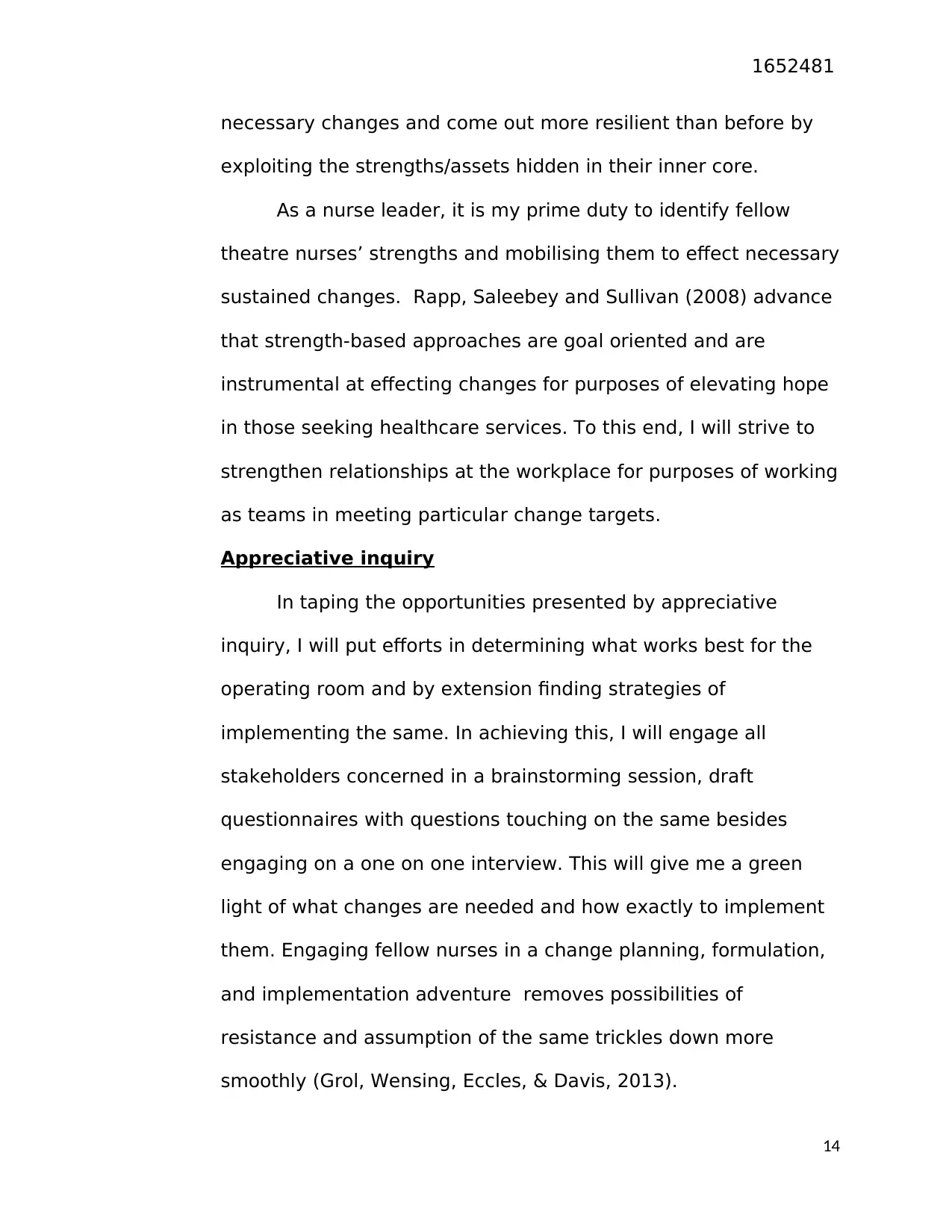
1652481
necessary changes and come out more resilient than before by
exploiting the strengths/assets hidden in their inner core.
As a nurse leader, it is my prime duty to identify fellow
theatre nurses’ strengths and mobilising them to effect necessary
sustained changes. Rapp, Saleebey and Sullivan (2008) advance
that strength-based approaches are goal oriented and are
instrumental at effecting changes for purposes of elevating hope
in those seeking healthcare services. To this end, I will strive to
strengthen relationships at the workplace for purposes of working
as teams in meeting particular change targets.
Appreciative inquiry
In taping the opportunities presented by appreciative
inquiry, I will put efforts in determining what works best for the
operating room and by extension finding strategies of
implementing the same. In achieving this, I will engage all
stakeholders concerned in a brainstorming session, draft
questionnaires with questions touching on the same besides
engaging on a one on one interview. This will give me a green
light of what changes are needed and how exactly to implement
them. Engaging fellow nurses in a change planning, formulation,
and implementation adventure removes possibilities of
resistance and assumption of the same trickles down more
smoothly (Grol, Wensing, Eccles, & Davis, 2013).
14
necessary changes and come out more resilient than before by
exploiting the strengths/assets hidden in their inner core.
As a nurse leader, it is my prime duty to identify fellow
theatre nurses’ strengths and mobilising them to effect necessary
sustained changes. Rapp, Saleebey and Sullivan (2008) advance
that strength-based approaches are goal oriented and are
instrumental at effecting changes for purposes of elevating hope
in those seeking healthcare services. To this end, I will strive to
strengthen relationships at the workplace for purposes of working
as teams in meeting particular change targets.
Appreciative inquiry
In taping the opportunities presented by appreciative
inquiry, I will put efforts in determining what works best for the
operating room and by extension finding strategies of
implementing the same. In achieving this, I will engage all
stakeholders concerned in a brainstorming session, draft
questionnaires with questions touching on the same besides
engaging on a one on one interview. This will give me a green
light of what changes are needed and how exactly to implement
them. Engaging fellow nurses in a change planning, formulation,
and implementation adventure removes possibilities of
resistance and assumption of the same trickles down more
smoothly (Grol, Wensing, Eccles, & Davis, 2013).
14
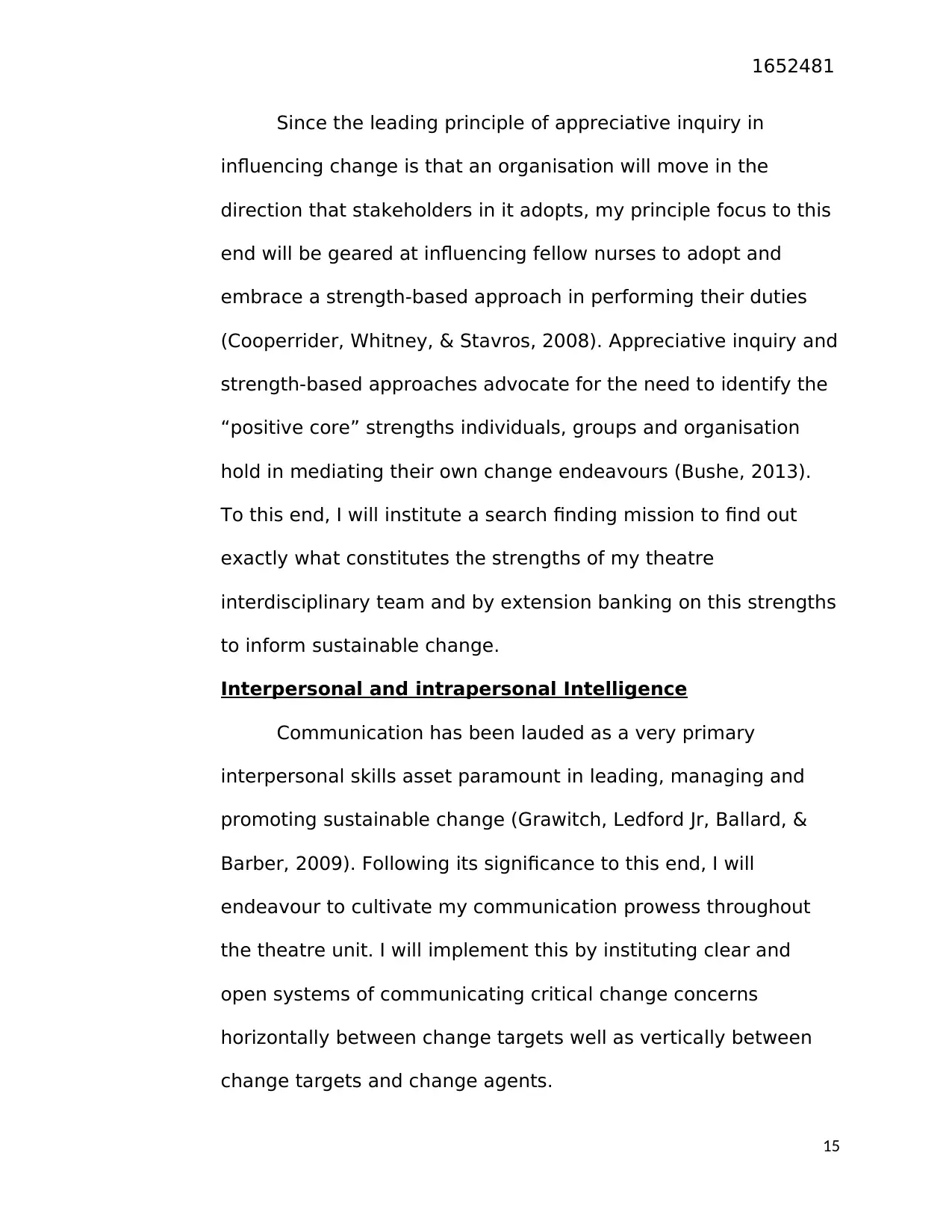
1652481
Since the leading principle of appreciative inquiry in
influencing change is that an organisation will move in the
direction that stakeholders in it adopts, my principle focus to this
end will be geared at influencing fellow nurses to adopt and
embrace a strength-based approach in performing their duties
(Cooperrider, Whitney, & Stavros, 2008). Appreciative inquiry and
strength-based approaches advocate for the need to identify the
“positive core” strengths individuals, groups and organisation
hold in mediating their own change endeavours (Bushe, 2013).
To this end, I will institute a search finding mission to find out
exactly what constitutes the strengths of my theatre
interdisciplinary team and by extension banking on this strengths
to inform sustainable change.
Interpersonal and intrapersonal Intelligence
Communication has been lauded as a very primary
interpersonal skills asset paramount in leading, managing and
promoting sustainable change (Grawitch, Ledford Jr, Ballard, &
Barber, 2009). Following its significance to this end, I will
endeavour to cultivate my communication prowess throughout
the theatre unit. I will implement this by instituting clear and
open systems of communicating critical change concerns
horizontally between change targets well as vertically between
change targets and change agents.
15
Since the leading principle of appreciative inquiry in
influencing change is that an organisation will move in the
direction that stakeholders in it adopts, my principle focus to this
end will be geared at influencing fellow nurses to adopt and
embrace a strength-based approach in performing their duties
(Cooperrider, Whitney, & Stavros, 2008). Appreciative inquiry and
strength-based approaches advocate for the need to identify the
“positive core” strengths individuals, groups and organisation
hold in mediating their own change endeavours (Bushe, 2013).
To this end, I will institute a search finding mission to find out
exactly what constitutes the strengths of my theatre
interdisciplinary team and by extension banking on this strengths
to inform sustainable change.
Interpersonal and intrapersonal Intelligence
Communication has been lauded as a very primary
interpersonal skills asset paramount in leading, managing and
promoting sustainable change (Grawitch, Ledford Jr, Ballard, &
Barber, 2009). Following its significance to this end, I will
endeavour to cultivate my communication prowess throughout
the theatre unit. I will implement this by instituting clear and
open systems of communicating critical change concerns
horizontally between change targets well as vertically between
change targets and change agents.
15
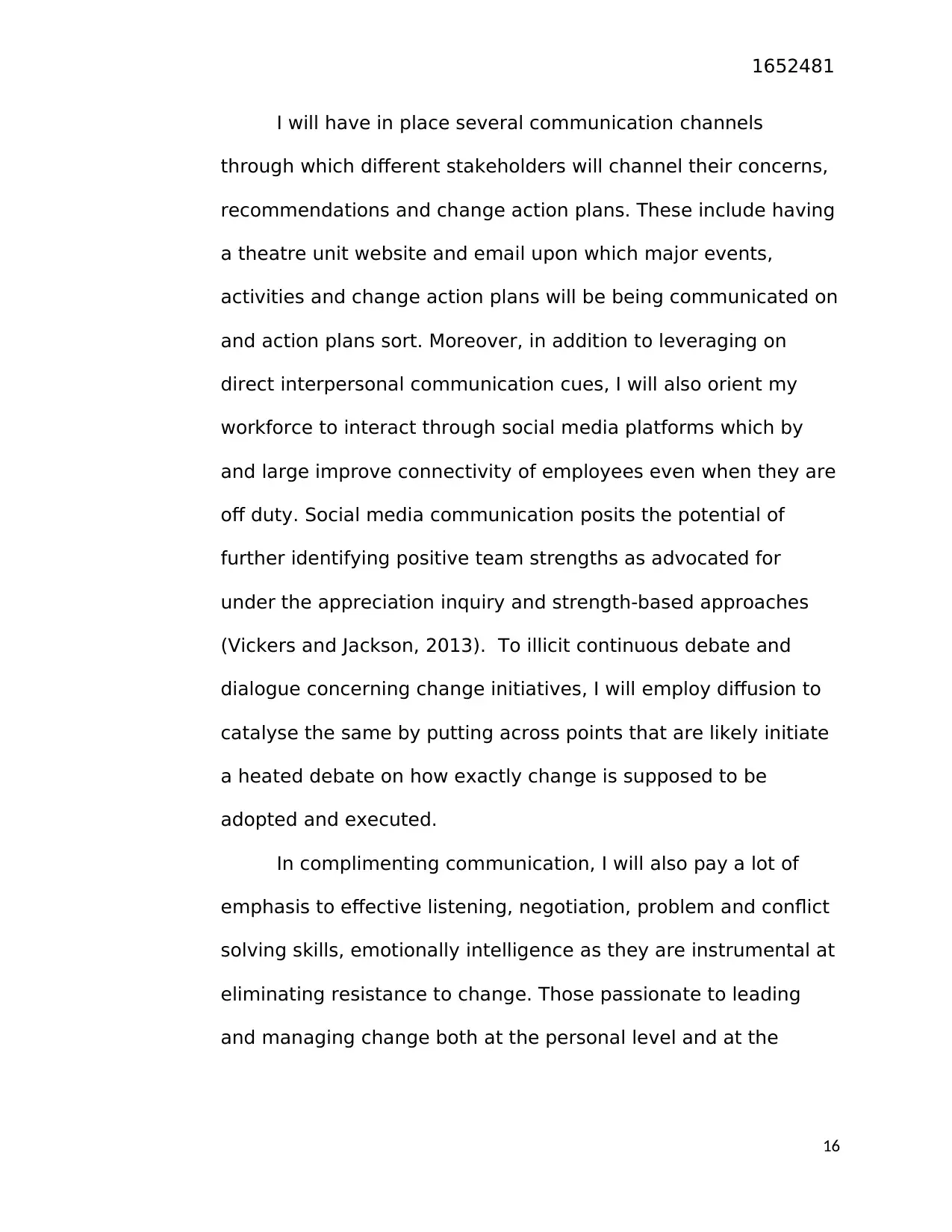
1652481
I will have in place several communication channels
through which different stakeholders will channel their concerns,
recommendations and change action plans. These include having
a theatre unit website and email upon which major events,
activities and change action plans will be being communicated on
and action plans sort. Moreover, in addition to leveraging on
direct interpersonal communication cues, I will also orient my
workforce to interact through social media platforms which by
and large improve connectivity of employees even when they are
off duty. Social media communication posits the potential of
further identifying positive team strengths as advocated for
under the appreciation inquiry and strength-based approaches
(Vickers and Jackson, 2013). To illicit continuous debate and
dialogue concerning change initiatives, I will employ diffusion to
catalyse the same by putting across points that are likely initiate
a heated debate on how exactly change is supposed to be
adopted and executed.
In complimenting communication, I will also pay a lot of
emphasis to effective listening, negotiation, problem and conflict
solving skills, emotionally intelligence as they are instrumental at
eliminating resistance to change. Those passionate to leading
and managing change both at the personal level and at the
16
I will have in place several communication channels
through which different stakeholders will channel their concerns,
recommendations and change action plans. These include having
a theatre unit website and email upon which major events,
activities and change action plans will be being communicated on
and action plans sort. Moreover, in addition to leveraging on
direct interpersonal communication cues, I will also orient my
workforce to interact through social media platforms which by
and large improve connectivity of employees even when they are
off duty. Social media communication posits the potential of
further identifying positive team strengths as advocated for
under the appreciation inquiry and strength-based approaches
(Vickers and Jackson, 2013). To illicit continuous debate and
dialogue concerning change initiatives, I will employ diffusion to
catalyse the same by putting across points that are likely initiate
a heated debate on how exactly change is supposed to be
adopted and executed.
In complimenting communication, I will also pay a lot of
emphasis to effective listening, negotiation, problem and conflict
solving skills, emotionally intelligence as they are instrumental at
eliminating resistance to change. Those passionate to leading
and managing change both at the personal level and at the
16
Secure Best Marks with AI Grader
Need help grading? Try our AI Grader for instant feedback on your assignments.
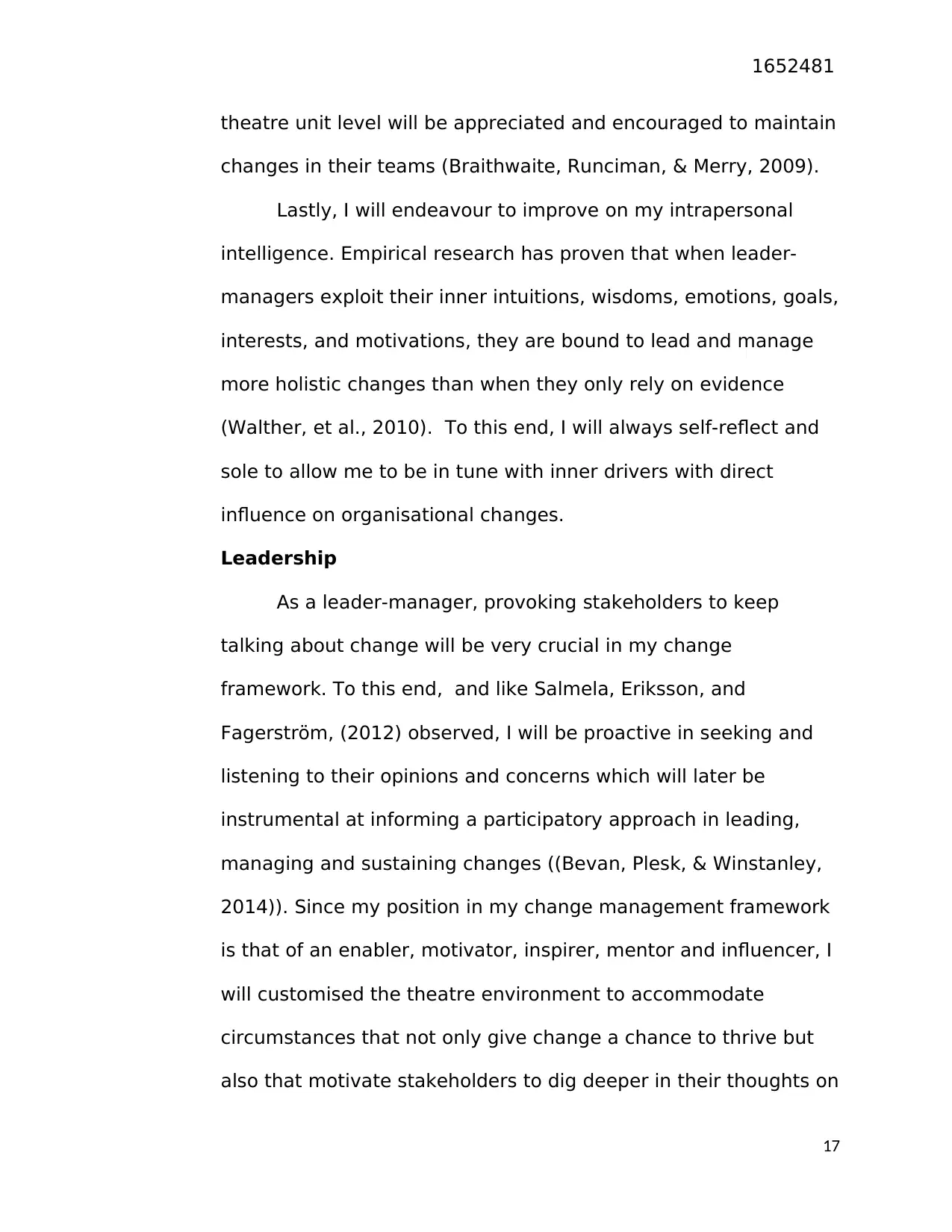
1652481
theatre unit level will be appreciated and encouraged to maintain
changes in their teams (Braithwaite, Runciman, & Merry, 2009).
Lastly, I will endeavour to improve on my intrapersonal
intelligence. Empirical research has proven that when leader-
managers exploit their inner intuitions, wisdoms, emotions, goals,
interests, and motivations, they are bound to lead and manage
more holistic changes than when they only rely on evidence
(Walther, et al., 2010). To this end, I will always self-reflect and
sole to allow me to be in tune with inner drivers with direct
influence on organisational changes.
Leadership
As a leader-manager, provoking stakeholders to keep
talking about change will be very crucial in my change
framework. To this end, and like Salmela, Eriksson, and
Fagerström, (2012) observed, I will be proactive in seeking and
listening to their opinions and concerns which will later be
instrumental at informing a participatory approach in leading,
managing and sustaining changes ((Bevan, Plesk, & Winstanley,
2014)). Since my position in my change management framework
is that of an enabler, motivator, inspirer, mentor and influencer, I
will customised the theatre environment to accommodate
circumstances that not only give change a chance to thrive but
also that motivate stakeholders to dig deeper in their thoughts on
17
theatre unit level will be appreciated and encouraged to maintain
changes in their teams (Braithwaite, Runciman, & Merry, 2009).
Lastly, I will endeavour to improve on my intrapersonal
intelligence. Empirical research has proven that when leader-
managers exploit their inner intuitions, wisdoms, emotions, goals,
interests, and motivations, they are bound to lead and manage
more holistic changes than when they only rely on evidence
(Walther, et al., 2010). To this end, I will always self-reflect and
sole to allow me to be in tune with inner drivers with direct
influence on organisational changes.
Leadership
As a leader-manager, provoking stakeholders to keep
talking about change will be very crucial in my change
framework. To this end, and like Salmela, Eriksson, and
Fagerström, (2012) observed, I will be proactive in seeking and
listening to their opinions and concerns which will later be
instrumental at informing a participatory approach in leading,
managing and sustaining changes ((Bevan, Plesk, & Winstanley,
2014)). Since my position in my change management framework
is that of an enabler, motivator, inspirer, mentor and influencer, I
will customised the theatre environment to accommodate
circumstances that not only give change a chance to thrive but
also that motivate stakeholders to dig deeper in their thoughts on
17
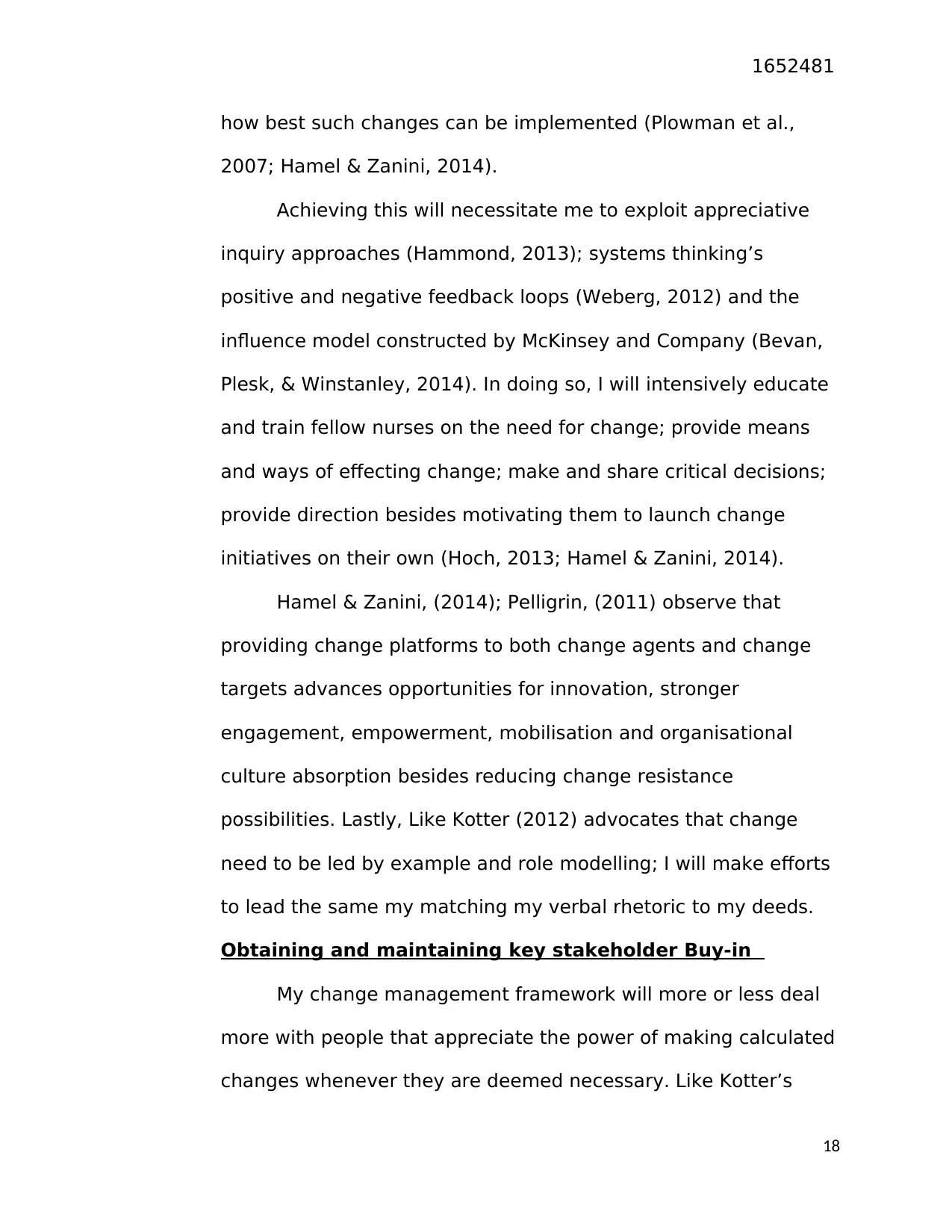
1652481
how best such changes can be implemented (Plowman et al.,
2007; Hamel & Zanini, 2014).
Achieving this will necessitate me to exploit appreciative
inquiry approaches (Hammond, 2013); systems thinking’s
positive and negative feedback loops (Weberg, 2012) and the
influence model constructed by McKinsey and Company (Bevan,
Plesk, & Winstanley, 2014). In doing so, I will intensively educate
and train fellow nurses on the need for change; provide means
and ways of effecting change; make and share critical decisions;
provide direction besides motivating them to launch change
initiatives on their own (Hoch, 2013; Hamel & Zanini, 2014).
Hamel & Zanini, (2014); Pelligrin, (2011) observe that
providing change platforms to both change agents and change
targets advances opportunities for innovation, stronger
engagement, empowerment, mobilisation and organisational
culture absorption besides reducing change resistance
possibilities. Lastly, Like Kotter (2012) advocates that change
need to be led by example and role modelling; I will make efforts
to lead the same my matching my verbal rhetoric to my deeds.
Obtaining and maintaining key stakeholder Buy-in
My change management framework will more or less deal
more with people that appreciate the power of making calculated
changes whenever they are deemed necessary. Like Kotter’s
18
how best such changes can be implemented (Plowman et al.,
2007; Hamel & Zanini, 2014).
Achieving this will necessitate me to exploit appreciative
inquiry approaches (Hammond, 2013); systems thinking’s
positive and negative feedback loops (Weberg, 2012) and the
influence model constructed by McKinsey and Company (Bevan,
Plesk, & Winstanley, 2014). In doing so, I will intensively educate
and train fellow nurses on the need for change; provide means
and ways of effecting change; make and share critical decisions;
provide direction besides motivating them to launch change
initiatives on their own (Hoch, 2013; Hamel & Zanini, 2014).
Hamel & Zanini, (2014); Pelligrin, (2011) observe that
providing change platforms to both change agents and change
targets advances opportunities for innovation, stronger
engagement, empowerment, mobilisation and organisational
culture absorption besides reducing change resistance
possibilities. Lastly, Like Kotter (2012) advocates that change
need to be led by example and role modelling; I will make efforts
to lead the same my matching my verbal rhetoric to my deeds.
Obtaining and maintaining key stakeholder Buy-in
My change management framework will more or less deal
more with people that appreciate the power of making calculated
changes whenever they are deemed necessary. Like Kotter’s
18
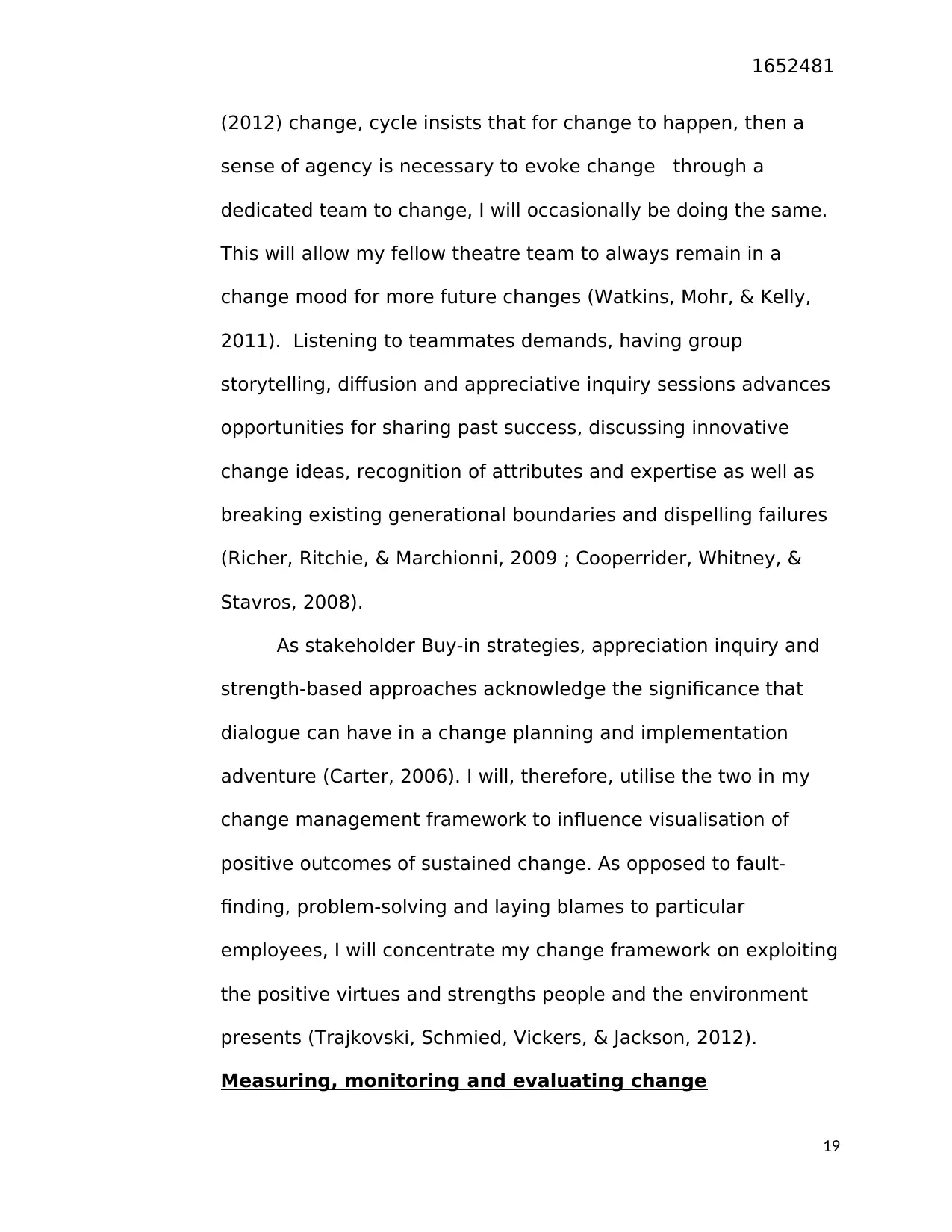
1652481
(2012) change, cycle insists that for change to happen, then a
sense of agency is necessary to evoke change through a
dedicated team to change, I will occasionally be doing the same.
This will allow my fellow theatre team to always remain in a
change mood for more future changes (Watkins, Mohr, & Kelly,
2011). Listening to teammates demands, having group
storytelling, diffusion and appreciative inquiry sessions advances
opportunities for sharing past success, discussing innovative
change ideas, recognition of attributes and expertise as well as
breaking existing generational boundaries and dispelling failures
(Richer, Ritchie, & Marchionni, 2009 ; Cooperrider, Whitney, &
Stavros, 2008).
As stakeholder Buy-in strategies, appreciation inquiry and
strength-based approaches acknowledge the significance that
dialogue can have in a change planning and implementation
adventure (Carter, 2006). I will, therefore, utilise the two in my
change management framework to influence visualisation of
positive outcomes of sustained change. As opposed to fault-
finding, problem-solving and laying blames to particular
employees, I will concentrate my change framework on exploiting
the positive virtues and strengths people and the environment
presents (Trajkovski, Schmied, Vickers, & Jackson, 2012).
Measuring, monitoring and evaluating change
19
(2012) change, cycle insists that for change to happen, then a
sense of agency is necessary to evoke change through a
dedicated team to change, I will occasionally be doing the same.
This will allow my fellow theatre team to always remain in a
change mood for more future changes (Watkins, Mohr, & Kelly,
2011). Listening to teammates demands, having group
storytelling, diffusion and appreciative inquiry sessions advances
opportunities for sharing past success, discussing innovative
change ideas, recognition of attributes and expertise as well as
breaking existing generational boundaries and dispelling failures
(Richer, Ritchie, & Marchionni, 2009 ; Cooperrider, Whitney, &
Stavros, 2008).
As stakeholder Buy-in strategies, appreciation inquiry and
strength-based approaches acknowledge the significance that
dialogue can have in a change planning and implementation
adventure (Carter, 2006). I will, therefore, utilise the two in my
change management framework to influence visualisation of
positive outcomes of sustained change. As opposed to fault-
finding, problem-solving and laying blames to particular
employees, I will concentrate my change framework on exploiting
the positive virtues and strengths people and the environment
presents (Trajkovski, Schmied, Vickers, & Jackson, 2012).
Measuring, monitoring and evaluating change
19
Paraphrase This Document
Need a fresh take? Get an instant paraphrase of this document with our AI Paraphraser
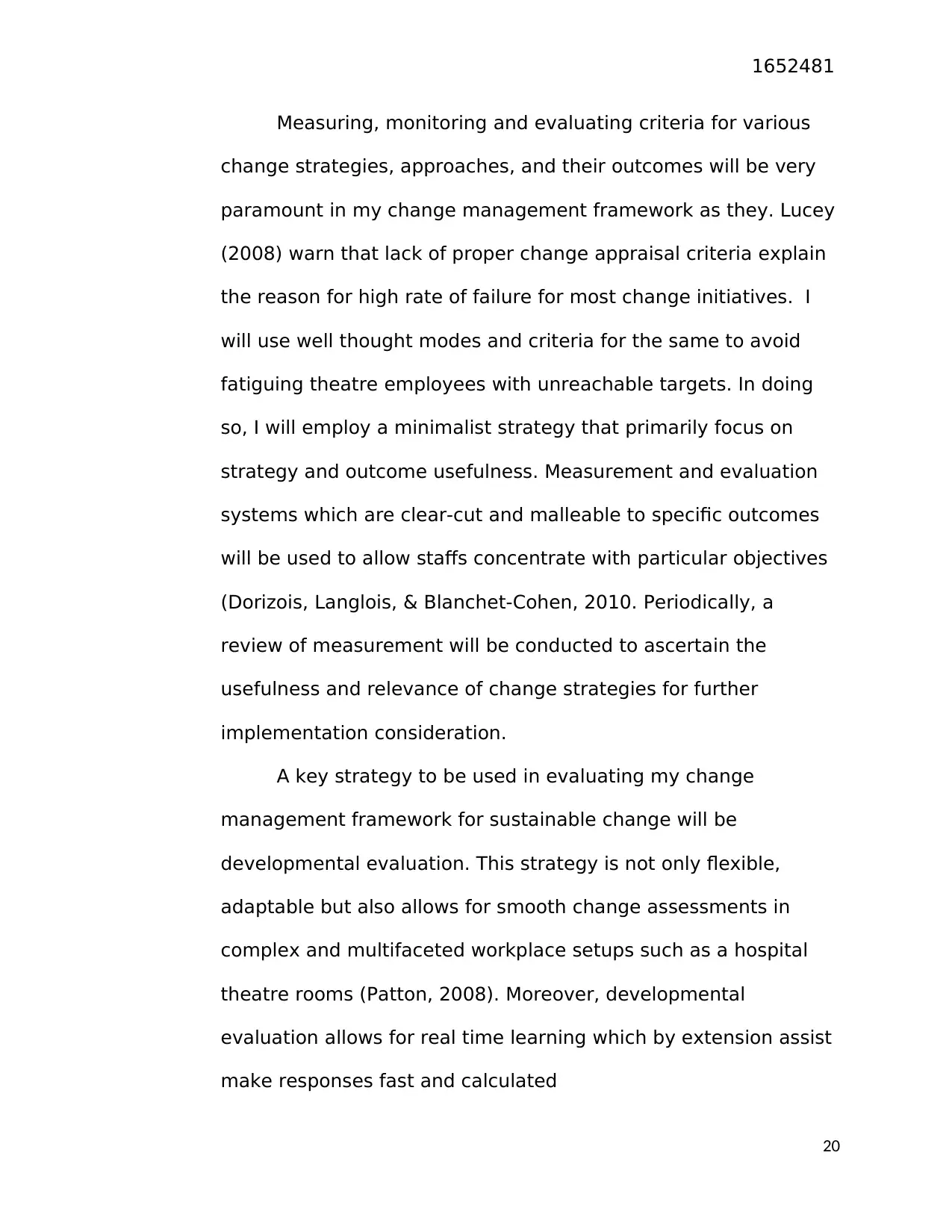
1652481
Measuring, monitoring and evaluating criteria for various
change strategies, approaches, and their outcomes will be very
paramount in my change management framework as they. Lucey
(2008) warn that lack of proper change appraisal criteria explain
the reason for high rate of failure for most change initiatives. I
will use well thought modes and criteria for the same to avoid
fatiguing theatre employees with unreachable targets. In doing
so, I will employ a minimalist strategy that primarily focus on
strategy and outcome usefulness. Measurement and evaluation
systems which are clear-cut and malleable to specific outcomes
will be used to allow staffs concentrate with particular objectives
(Dorizois, Langlois, & Blanchet-Cohen, 2010. Periodically, a
review of measurement will be conducted to ascertain the
usefulness and relevance of change strategies for further
implementation consideration.
A key strategy to be used in evaluating my change
management framework for sustainable change will be
developmental evaluation. This strategy is not only flexible,
adaptable but also allows for smooth change assessments in
complex and multifaceted workplace setups such as a hospital
theatre rooms (Patton, 2008). Moreover, developmental
evaluation allows for real time learning which by extension assist
make responses fast and calculated
20
Measuring, monitoring and evaluating criteria for various
change strategies, approaches, and their outcomes will be very
paramount in my change management framework as they. Lucey
(2008) warn that lack of proper change appraisal criteria explain
the reason for high rate of failure for most change initiatives. I
will use well thought modes and criteria for the same to avoid
fatiguing theatre employees with unreachable targets. In doing
so, I will employ a minimalist strategy that primarily focus on
strategy and outcome usefulness. Measurement and evaluation
systems which are clear-cut and malleable to specific outcomes
will be used to allow staffs concentrate with particular objectives
(Dorizois, Langlois, & Blanchet-Cohen, 2010. Periodically, a
review of measurement will be conducted to ascertain the
usefulness and relevance of change strategies for further
implementation consideration.
A key strategy to be used in evaluating my change
management framework for sustainable change will be
developmental evaluation. This strategy is not only flexible,
adaptable but also allows for smooth change assessments in
complex and multifaceted workplace setups such as a hospital
theatre rooms (Patton, 2008). Moreover, developmental
evaluation allows for real time learning which by extension assist
make responses fast and calculated
20
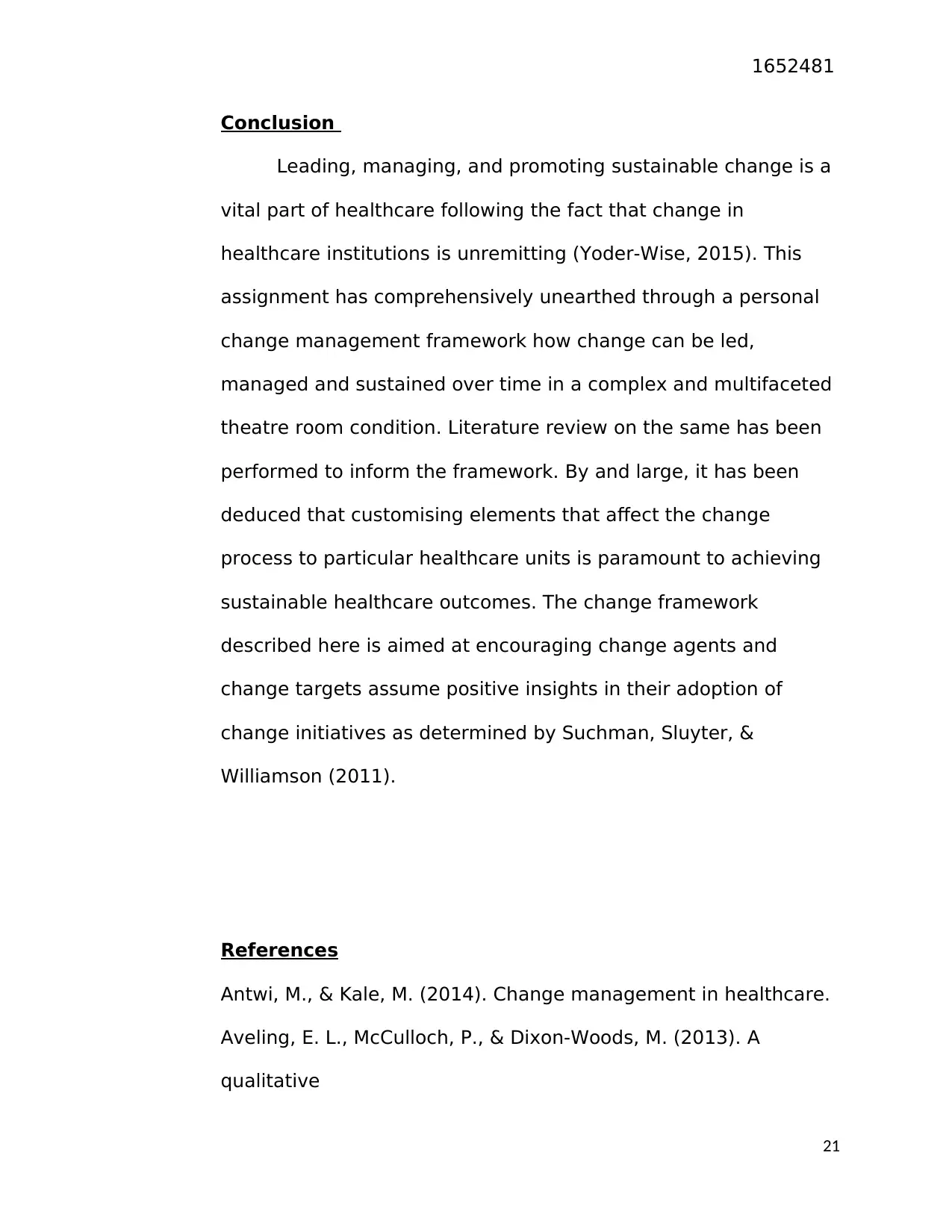
1652481
Conclusion
Leading, managing, and promoting sustainable change is a
vital part of healthcare following the fact that change in
healthcare institutions is unremitting (Yoder-Wise, 2015). This
assignment has comprehensively unearthed through a personal
change management framework how change can be led,
managed and sustained over time in a complex and multifaceted
theatre room condition. Literature review on the same has been
performed to inform the framework. By and large, it has been
deduced that customising elements that affect the change
process to particular healthcare units is paramount to achieving
sustainable healthcare outcomes. The change framework
described here is aimed at encouraging change agents and
change targets assume positive insights in their adoption of
change initiatives as determined by Suchman, Sluyter, &
Williamson (2011).
References
Antwi, M., & Kale, M. (2014). Change management in healthcare.
Aveling, E. L., McCulloch, P., & Dixon-Woods, M. (2013). A
qualitative
21
Conclusion
Leading, managing, and promoting sustainable change is a
vital part of healthcare following the fact that change in
healthcare institutions is unremitting (Yoder-Wise, 2015). This
assignment has comprehensively unearthed through a personal
change management framework how change can be led,
managed and sustained over time in a complex and multifaceted
theatre room condition. Literature review on the same has been
performed to inform the framework. By and large, it has been
deduced that customising elements that affect the change
process to particular healthcare units is paramount to achieving
sustainable healthcare outcomes. The change framework
described here is aimed at encouraging change agents and
change targets assume positive insights in their adoption of
change initiatives as determined by Suchman, Sluyter, &
Williamson (2011).
References
Antwi, M., & Kale, M. (2014). Change management in healthcare.
Aveling, E. L., McCulloch, P., & Dixon-Woods, M. (2013). A
qualitative
21
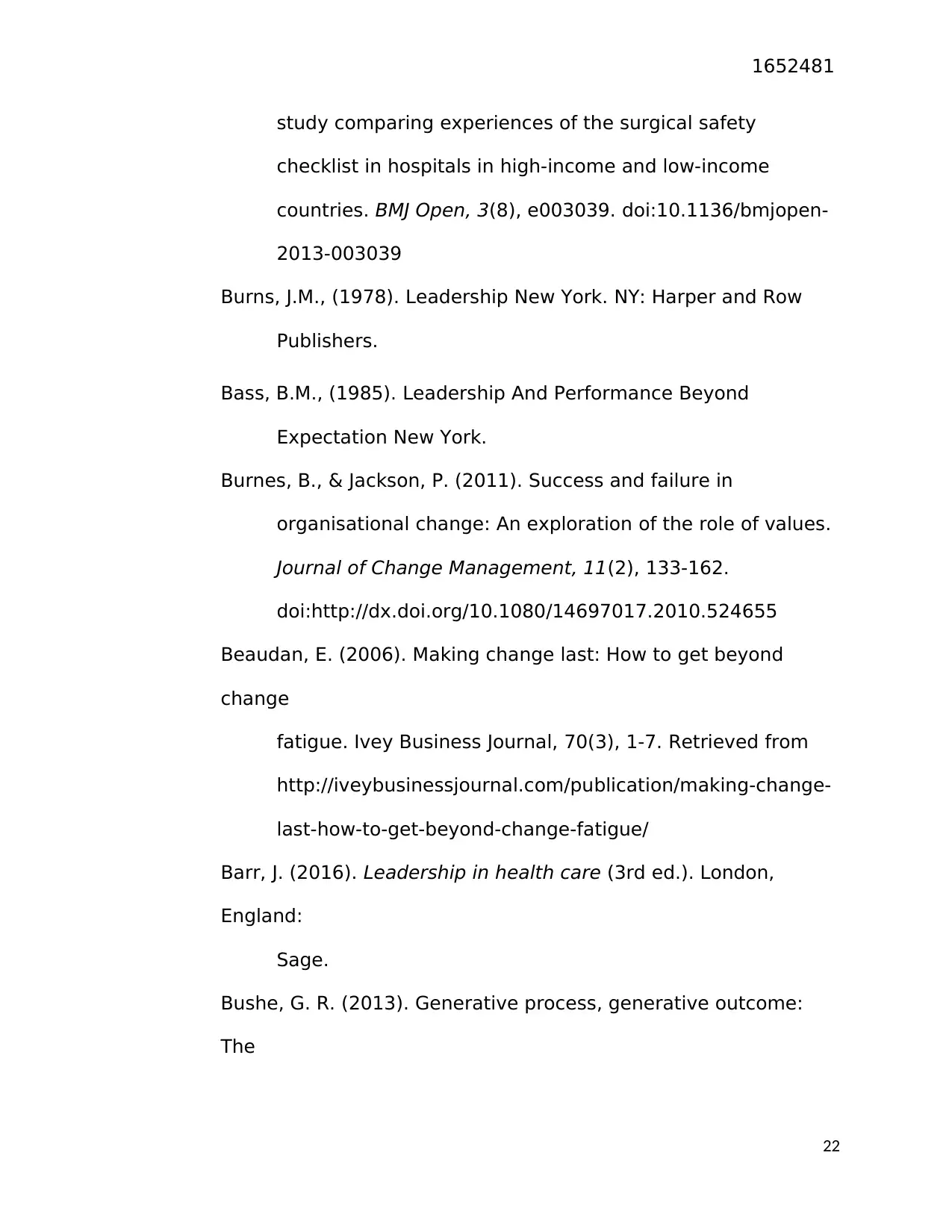
1652481
study comparing experiences of the surgical safety
checklist in hospitals in high-income and low-income
countries. BMJ Open, 3(8), e003039. doi:10.1136/bmjopen-
2013-003039
Burns, J.M., (1978). Leadership New York. NY: Harper and Row
Publishers.
Bass, B.M., (1985). Leadership And Performance Beyond
Expectation New York.
Burnes, B., & Jackson, P. (2011). Success and failure in
organisational change: An exploration of the role of values.
Journal of Change Management, 11(2), 133-162.
doi:http://dx.doi.org/10.1080/14697017.2010.524655
Beaudan, E. (2006). Making change last: How to get beyond
change
fatigue. Ivey Business Journal, 70(3), 1-7. Retrieved from
http://iveybusinessjournal.com/publication/making-change-
last-how-to-get-beyond-change-fatigue/
Barr, J. (2016). Leadership in health care (3rd ed.). London,
England:
Sage.
Bushe, G. R. (2013). Generative process, generative outcome:
The
22
study comparing experiences of the surgical safety
checklist in hospitals in high-income and low-income
countries. BMJ Open, 3(8), e003039. doi:10.1136/bmjopen-
2013-003039
Burns, J.M., (1978). Leadership New York. NY: Harper and Row
Publishers.
Bass, B.M., (1985). Leadership And Performance Beyond
Expectation New York.
Burnes, B., & Jackson, P. (2011). Success and failure in
organisational change: An exploration of the role of values.
Journal of Change Management, 11(2), 133-162.
doi:http://dx.doi.org/10.1080/14697017.2010.524655
Beaudan, E. (2006). Making change last: How to get beyond
change
fatigue. Ivey Business Journal, 70(3), 1-7. Retrieved from
http://iveybusinessjournal.com/publication/making-change-
last-how-to-get-beyond-change-fatigue/
Barr, J. (2016). Leadership in health care (3rd ed.). London,
England:
Sage.
Bushe, G. R. (2013). Generative process, generative outcome:
The
22
Secure Best Marks with AI Grader
Need help grading? Try our AI Grader for instant feedback on your assignments.
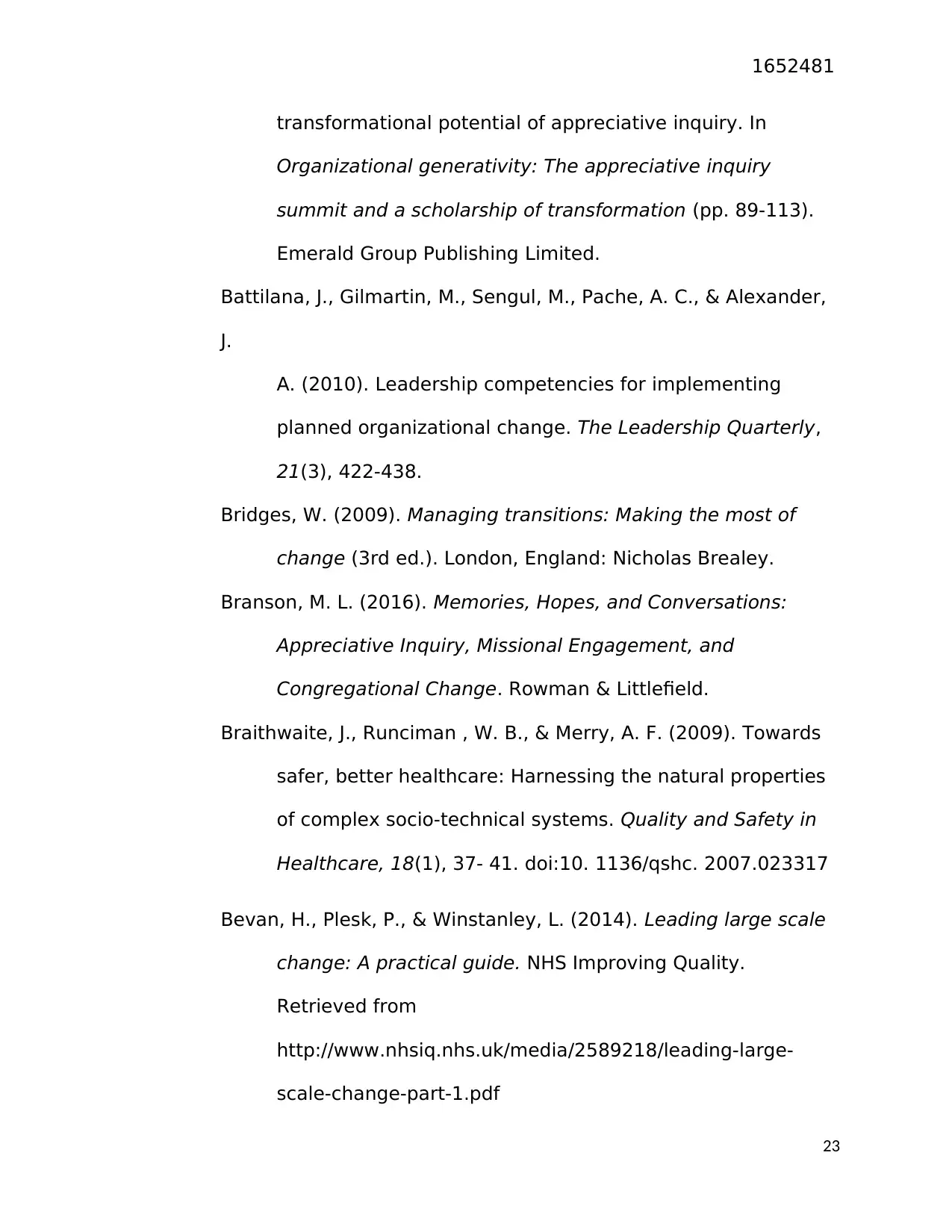
1652481
transformational potential of appreciative inquiry. In
Organizational generativity: The appreciative inquiry
summit and a scholarship of transformation (pp. 89-113).
Emerald Group Publishing Limited.
Battilana, J., Gilmartin, M., Sengul, M., Pache, A. C., & Alexander,
J.
A. (2010). Leadership competencies for implementing
planned organizational change. The Leadership Quarterly,
21(3), 422-438.
Bridges, W. (2009). Managing transitions: Making the most of
change (3rd ed.). London, England: Nicholas Brealey.
Branson, M. L. (2016). Memories, Hopes, and Conversations:
Appreciative Inquiry, Missional Engagement, and
Congregational Change. Rowman & Littlefield.
Braithwaite, J., Runciman , W. B., & Merry, A. F. (2009). Towards
safer, better healthcare: Harnessing the natural properties
of complex socio-technical systems. Quality and Safety in
Healthcare, 18(1), 37- 41. doi:10. 1136/qshc. 2007.023317
Bevan, H., Plesk, P., & Winstanley, L. (2014). Leading large scale
change: A practical guide. NHS Improving Quality.
Retrieved from
http://www.nhsiq.nhs.uk/media/2589218/leading-large-
scale-change-part-1.pdf
23
transformational potential of appreciative inquiry. In
Organizational generativity: The appreciative inquiry
summit and a scholarship of transformation (pp. 89-113).
Emerald Group Publishing Limited.
Battilana, J., Gilmartin, M., Sengul, M., Pache, A. C., & Alexander,
J.
A. (2010). Leadership competencies for implementing
planned organizational change. The Leadership Quarterly,
21(3), 422-438.
Bridges, W. (2009). Managing transitions: Making the most of
change (3rd ed.). London, England: Nicholas Brealey.
Branson, M. L. (2016). Memories, Hopes, and Conversations:
Appreciative Inquiry, Missional Engagement, and
Congregational Change. Rowman & Littlefield.
Braithwaite, J., Runciman , W. B., & Merry, A. F. (2009). Towards
safer, better healthcare: Harnessing the natural properties
of complex socio-technical systems. Quality and Safety in
Healthcare, 18(1), 37- 41. doi:10. 1136/qshc. 2007.023317
Bevan, H., Plesk, P., & Winstanley, L. (2014). Leading large scale
change: A practical guide. NHS Improving Quality.
Retrieved from
http://www.nhsiq.nhs.uk/media/2589218/leading-large-
scale-change-part-1.pdf
23
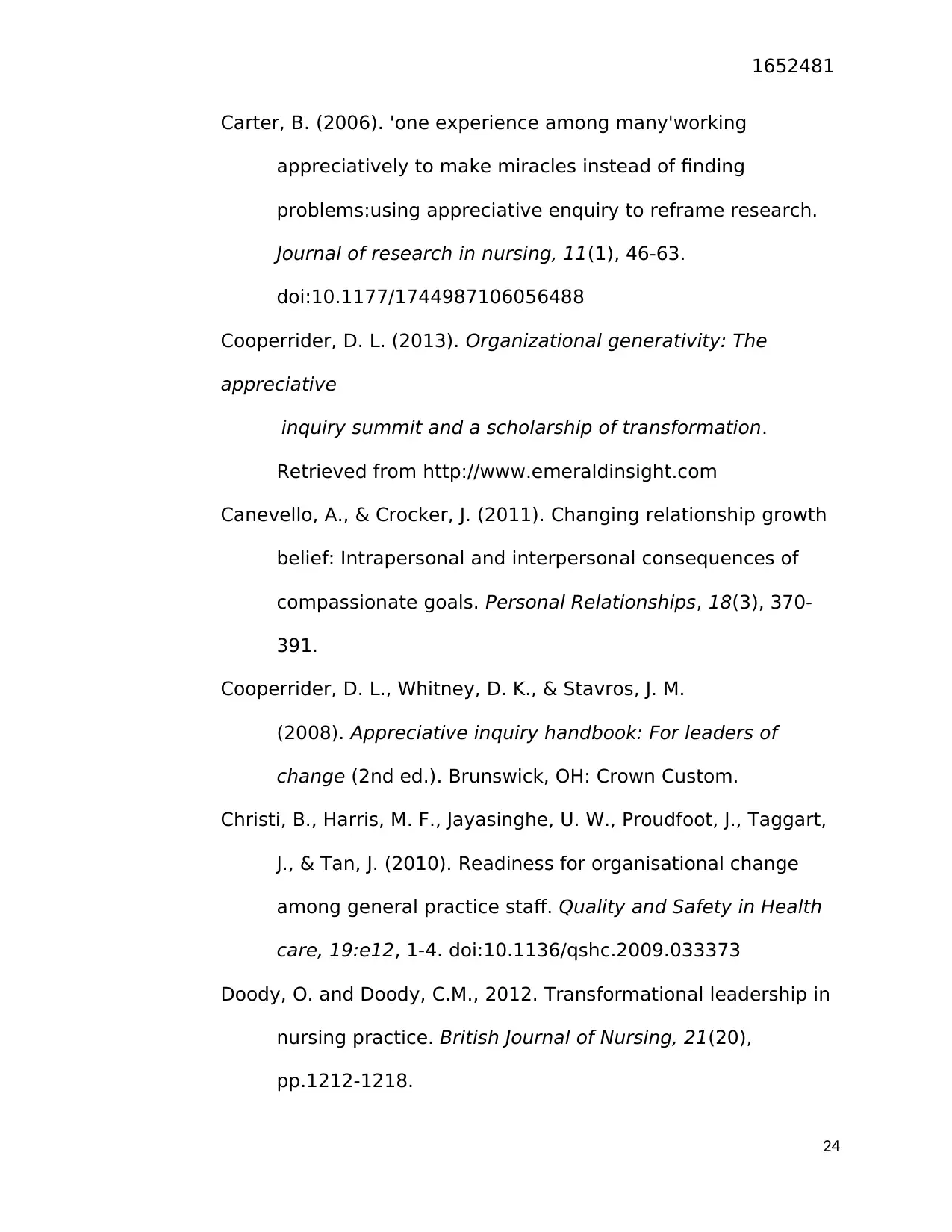
1652481
Carter, B. (2006). 'one experience among many'working
appreciatively to make miracles instead of finding
problems:using appreciative enquiry to reframe research.
Journal of research in nursing, 11(1), 46-63.
doi:10.1177/1744987106056488
Cooperrider, D. L. (2013). Organizational generativity: The
appreciative
inquiry summit and a scholarship of transformation.
Retrieved from http://www.emeraldinsight.com
Canevello, A., & Crocker, J. (2011). Changing relationship growth
belief: Intrapersonal and interpersonal consequences of
compassionate goals. Personal Relationships, 18(3), 370-
391.
Cooperrider, D. L., Whitney, D. K., & Stavros, J. M.
(2008). Appreciative inquiry handbook: For leaders of
change (2nd ed.). Brunswick, OH: Crown Custom.
Christi, B., Harris, M. F., Jayasinghe, U. W., Proudfoot, J., Taggart,
J., & Tan, J. (2010). Readiness for organisational change
among general practice staff. Quality and Safety in Health
care, 19:e12, 1-4. doi:10.1136/qshc.2009.033373
Doody, O. and Doody, C.M., 2012. Transformational leadership in
nursing practice. British Journal of Nursing, 21(20),
pp.1212-1218.
24
Carter, B. (2006). 'one experience among many'working
appreciatively to make miracles instead of finding
problems:using appreciative enquiry to reframe research.
Journal of research in nursing, 11(1), 46-63.
doi:10.1177/1744987106056488
Cooperrider, D. L. (2013). Organizational generativity: The
appreciative
inquiry summit and a scholarship of transformation.
Retrieved from http://www.emeraldinsight.com
Canevello, A., & Crocker, J. (2011). Changing relationship growth
belief: Intrapersonal and interpersonal consequences of
compassionate goals. Personal Relationships, 18(3), 370-
391.
Cooperrider, D. L., Whitney, D. K., & Stavros, J. M.
(2008). Appreciative inquiry handbook: For leaders of
change (2nd ed.). Brunswick, OH: Crown Custom.
Christi, B., Harris, M. F., Jayasinghe, U. W., Proudfoot, J., Taggart,
J., & Tan, J. (2010). Readiness for organisational change
among general practice staff. Quality and Safety in Health
care, 19:e12, 1-4. doi:10.1136/qshc.2009.033373
Doody, O. and Doody, C.M., 2012. Transformational leadership in
nursing practice. British Journal of Nursing, 21(20),
pp.1212-1218.
24
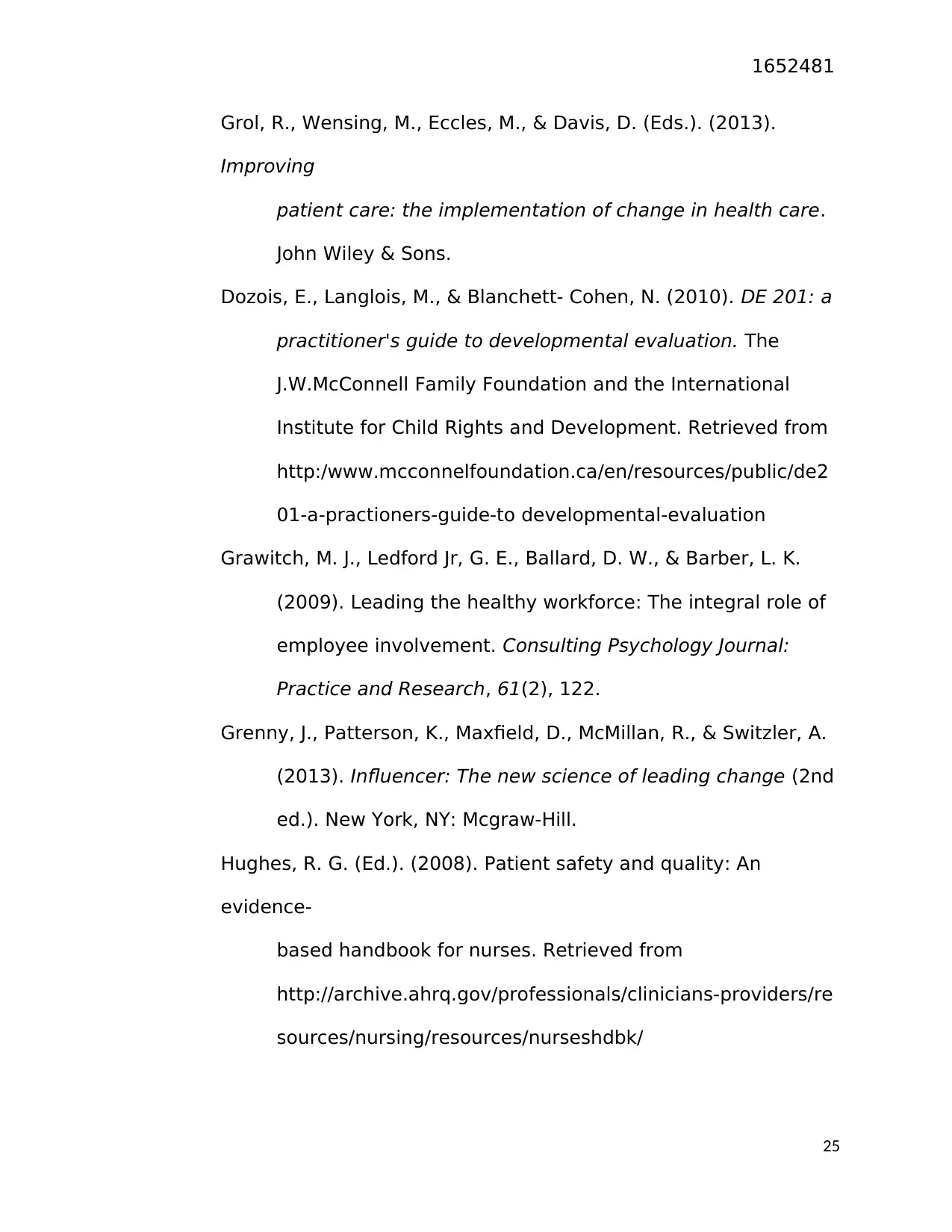
1652481
Grol, R., Wensing, M., Eccles, M., & Davis, D. (Eds.). (2013).
Improving
patient care: the implementation of change in health care.
John Wiley & Sons.
Dozois, E., Langlois, M., & Blanchett- Cohen, N. (2010). DE 201: a
practitioner's guide to developmental evaluation. The
J.W.McConnell Family Foundation and the International
Institute for Child Rights and Development. Retrieved from
http:/www.mcconnelfoundation.ca/en/resources/public/de2
01-a-practioners-guide-to developmental-evaluation
Grawitch, M. J., Ledford Jr, G. E., Ballard, D. W., & Barber, L. K.
(2009). Leading the healthy workforce: The integral role of
employee involvement. Consulting Psychology Journal:
Practice and Research, 61(2), 122.
Grenny, J., Patterson, K., Maxfield, D., McMillan, R., & Switzler, A.
(2013). Influencer: The new science of leading change (2nd
ed.). New York, NY: Mcgraw-Hill.
Hughes, R. G. (Ed.). (2008). Patient safety and quality: An
evidence-
based handbook for nurses. Retrieved from
http://archive.ahrq.gov/professionals/clinicians-providers/re
sources/nursing/resources/nurseshdbk/
25
Grol, R., Wensing, M., Eccles, M., & Davis, D. (Eds.). (2013).
Improving
patient care: the implementation of change in health care.
John Wiley & Sons.
Dozois, E., Langlois, M., & Blanchett- Cohen, N. (2010). DE 201: a
practitioner's guide to developmental evaluation. The
J.W.McConnell Family Foundation and the International
Institute for Child Rights and Development. Retrieved from
http:/www.mcconnelfoundation.ca/en/resources/public/de2
01-a-practioners-guide-to developmental-evaluation
Grawitch, M. J., Ledford Jr, G. E., Ballard, D. W., & Barber, L. K.
(2009). Leading the healthy workforce: The integral role of
employee involvement. Consulting Psychology Journal:
Practice and Research, 61(2), 122.
Grenny, J., Patterson, K., Maxfield, D., McMillan, R., & Switzler, A.
(2013). Influencer: The new science of leading change (2nd
ed.). New York, NY: Mcgraw-Hill.
Hughes, R. G. (Ed.). (2008). Patient safety and quality: An
evidence-
based handbook for nurses. Retrieved from
http://archive.ahrq.gov/professionals/clinicians-providers/re
sources/nursing/resources/nurseshdbk/
25
Paraphrase This Document
Need a fresh take? Get an instant paraphrase of this document with our AI Paraphraser
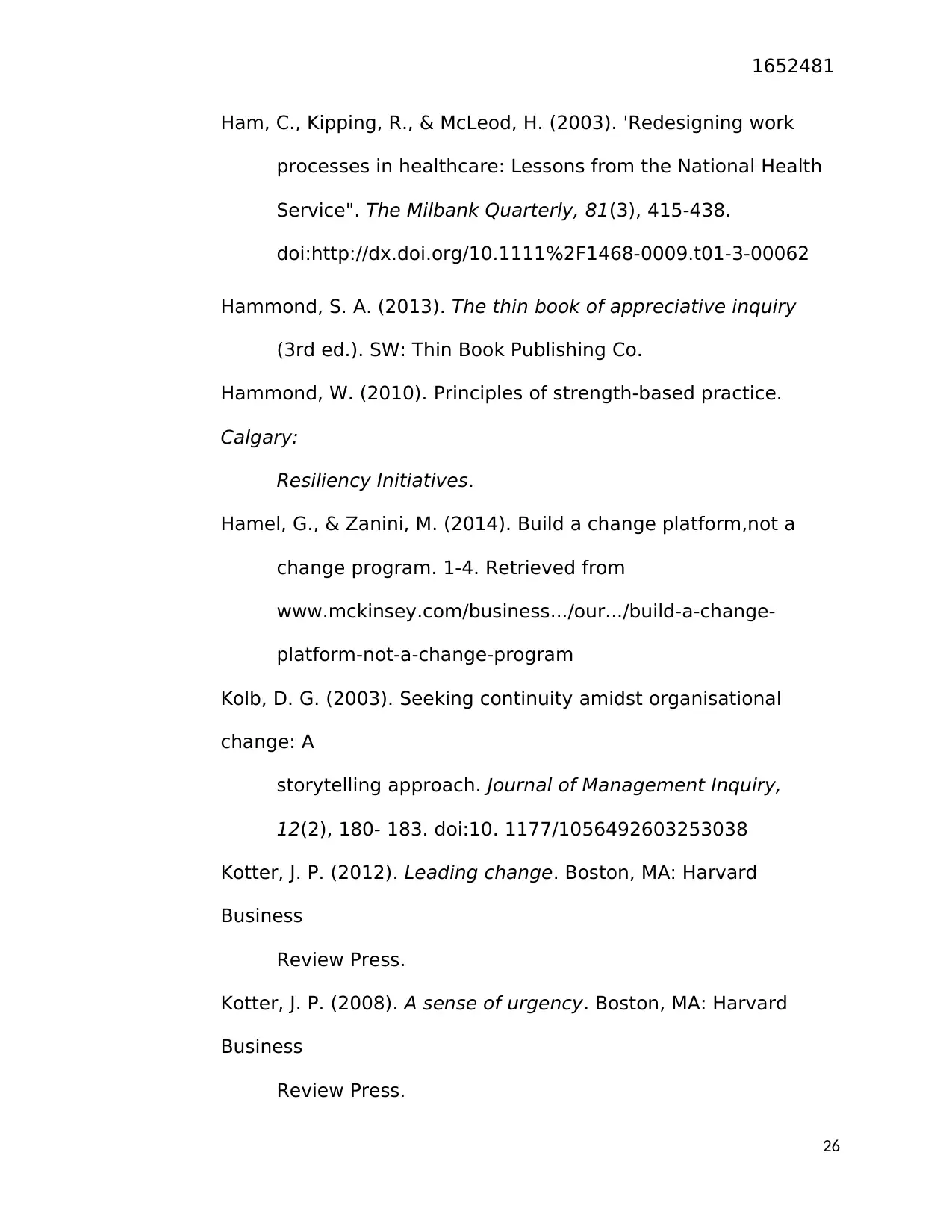
1652481
Ham, C., Kipping, R., & McLeod, H. (2003). 'Redesigning work
processes in healthcare: Lessons from the National Health
Service". The Milbank Quarterly, 81(3), 415-438.
doi:http://dx.doi.org/10.1111%2F1468-0009.t01-3-00062
Hammond, S. A. (2013). The thin book of appreciative inquiry
(3rd ed.). SW: Thin Book Publishing Co.
Hammond, W. (2010). Principles of strength-based practice.
Calgary:
Resiliency Initiatives.
Hamel, G., & Zanini, M. (2014). Build a change platform,not a
change program. 1-4. Retrieved from
www.mckinsey.com/business.../our.../build-a-change-
platform-not-a-change-program
Kolb, D. G. (2003). Seeking continuity amidst organisational
change: A
storytelling approach. Journal of Management Inquiry,
12(2), 180- 183. doi:10. 1177/1056492603253038
Kotter, J. P. (2012). Leading change. Boston, MA: Harvard
Business
Review Press.
Kotter, J. P. (2008). A sense of urgency. Boston, MA: Harvard
Business
Review Press.
26
Ham, C., Kipping, R., & McLeod, H. (2003). 'Redesigning work
processes in healthcare: Lessons from the National Health
Service". The Milbank Quarterly, 81(3), 415-438.
doi:http://dx.doi.org/10.1111%2F1468-0009.t01-3-00062
Hammond, S. A. (2013). The thin book of appreciative inquiry
(3rd ed.). SW: Thin Book Publishing Co.
Hammond, W. (2010). Principles of strength-based practice.
Calgary:
Resiliency Initiatives.
Hamel, G., & Zanini, M. (2014). Build a change platform,not a
change program. 1-4. Retrieved from
www.mckinsey.com/business.../our.../build-a-change-
platform-not-a-change-program
Kolb, D. G. (2003). Seeking continuity amidst organisational
change: A
storytelling approach. Journal of Management Inquiry,
12(2), 180- 183. doi:10. 1177/1056492603253038
Kotter, J. P. (2012). Leading change. Boston, MA: Harvard
Business
Review Press.
Kotter, J. P. (2008). A sense of urgency. Boston, MA: Harvard
Business
Review Press.
26
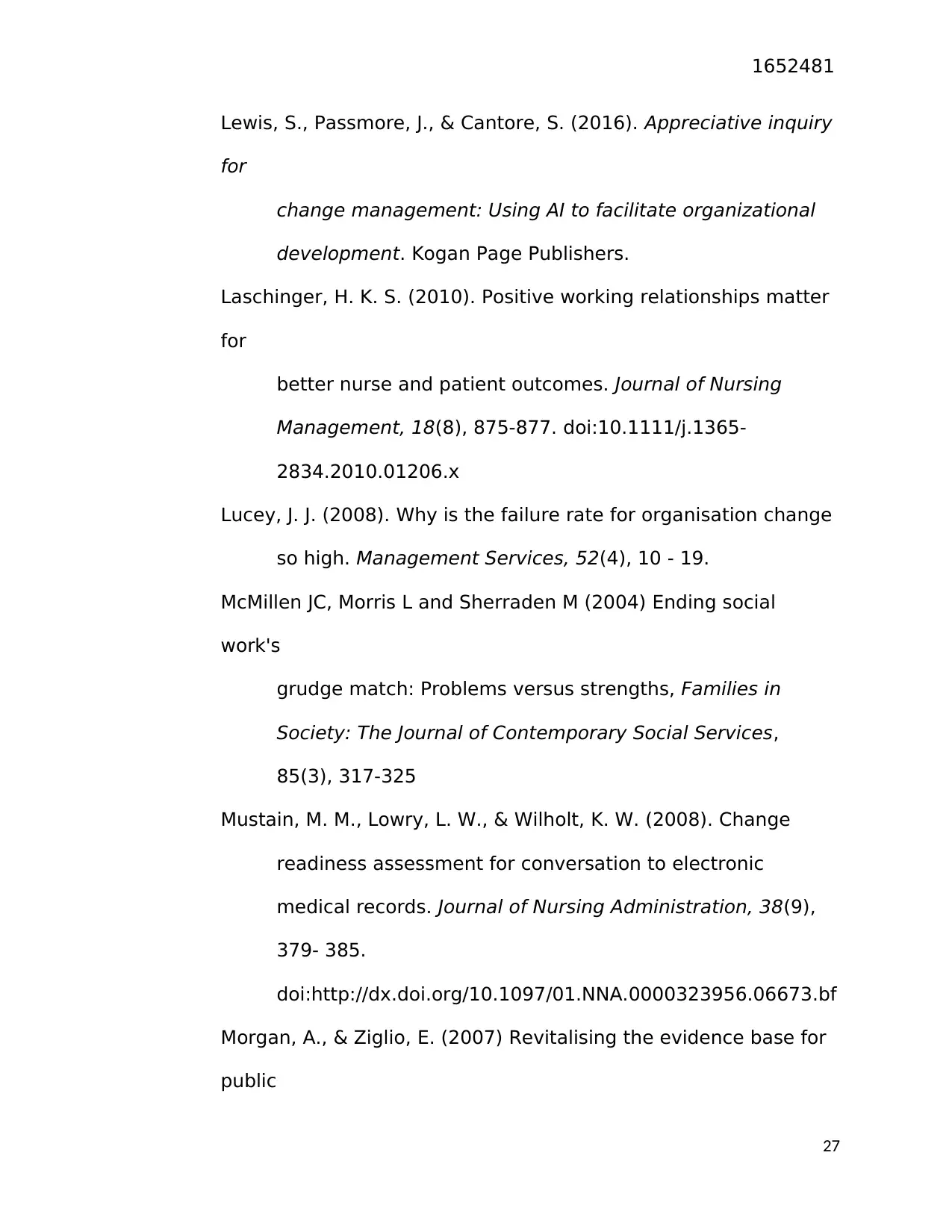
1652481
Lewis, S., Passmore, J., & Cantore, S. (2016). Appreciative inquiry
for
change management: Using AI to facilitate organizational
development. Kogan Page Publishers.
Laschinger, H. K. S. (2010). Positive working relationships matter
for
better nurse and patient outcomes. Journal of Nursing
Management, 18(8), 875-877. doi:10.1111/j.1365-
2834.2010.01206.x
Lucey, J. J. (2008). Why is the failure rate for organisation change
so high. Management Services, 52(4), 10 - 19.
McMillen JC, Morris L and Sherraden M (2004) Ending social
work's
grudge match: Problems versus strengths, Families in
Society: The Journal of Contemporary Social Services,
85(3), 317-325
Mustain, M. M., Lowry, L. W., & Wilholt, K. W. (2008). Change
readiness assessment for conversation to electronic
medical records. Journal of Nursing Administration, 38(9),
379- 385.
doi:http://dx.doi.org/10.1097/01.NNA.0000323956.06673.bf
Morgan, A., & Ziglio, E. (2007) Revitalising the evidence base for
public
27
Lewis, S., Passmore, J., & Cantore, S. (2016). Appreciative inquiry
for
change management: Using AI to facilitate organizational
development. Kogan Page Publishers.
Laschinger, H. K. S. (2010). Positive working relationships matter
for
better nurse and patient outcomes. Journal of Nursing
Management, 18(8), 875-877. doi:10.1111/j.1365-
2834.2010.01206.x
Lucey, J. J. (2008). Why is the failure rate for organisation change
so high. Management Services, 52(4), 10 - 19.
McMillen JC, Morris L and Sherraden M (2004) Ending social
work's
grudge match: Problems versus strengths, Families in
Society: The Journal of Contemporary Social Services,
85(3), 317-325
Mustain, M. M., Lowry, L. W., & Wilholt, K. W. (2008). Change
readiness assessment for conversation to electronic
medical records. Journal of Nursing Administration, 38(9),
379- 385.
doi:http://dx.doi.org/10.1097/01.NNA.0000323956.06673.bf
Morgan, A., & Ziglio, E. (2007) Revitalising the evidence base for
public
27
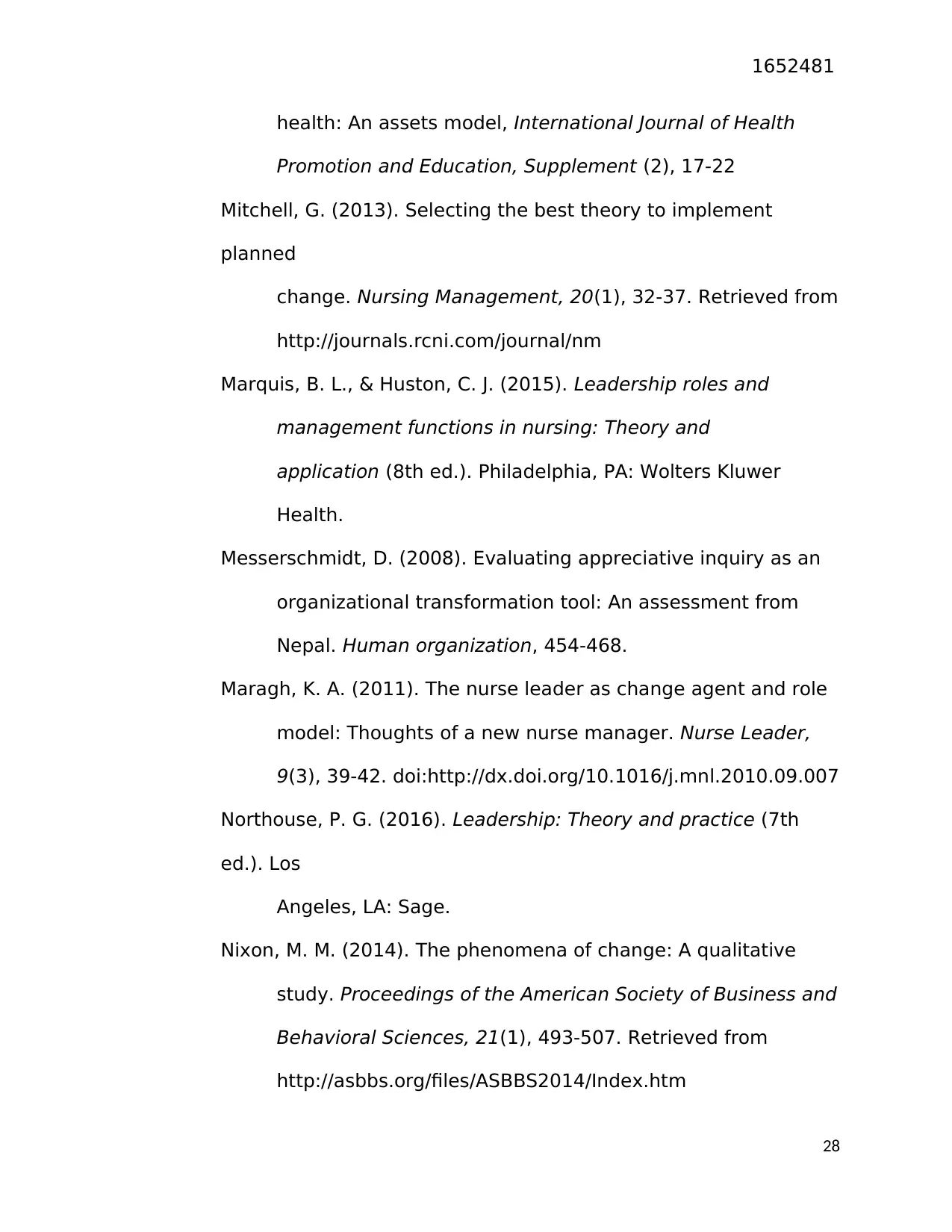
1652481
health: An assets model, International Journal of Health
Promotion and Education, Supplement (2), 17-22
Mitchell, G. (2013). Selecting the best theory to implement
planned
change. Nursing Management, 20(1), 32-37. Retrieved from
http://journals.rcni.com/journal/nm
Marquis, B. L., & Huston, C. J. (2015). Leadership roles and
management functions in nursing: Theory and
application (8th ed.). Philadelphia, PA: Wolters Kluwer
Health.
Messerschmidt, D. (2008). Evaluating appreciative inquiry as an
organizational transformation tool: An assessment from
Nepal. Human organization, 454-468.
Maragh, K. A. (2011). The nurse leader as change agent and role
model: Thoughts of a new nurse manager. Nurse Leader,
9(3), 39-42. doi:http://dx.doi.org/10.1016/j.mnl.2010.09.007
Northouse, P. G. (2016). Leadership: Theory and practice (7th
ed.). Los
Angeles, LA: Sage.
Nixon, M. M. (2014). The phenomena of change: A qualitative
study. Proceedings of the American Society of Business and
Behavioral Sciences, 21(1), 493-507. Retrieved from
http://asbbs.org/files/ASBBS2014/Index.htm
28
health: An assets model, International Journal of Health
Promotion and Education, Supplement (2), 17-22
Mitchell, G. (2013). Selecting the best theory to implement
planned
change. Nursing Management, 20(1), 32-37. Retrieved from
http://journals.rcni.com/journal/nm
Marquis, B. L., & Huston, C. J. (2015). Leadership roles and
management functions in nursing: Theory and
application (8th ed.). Philadelphia, PA: Wolters Kluwer
Health.
Messerschmidt, D. (2008). Evaluating appreciative inquiry as an
organizational transformation tool: An assessment from
Nepal. Human organization, 454-468.
Maragh, K. A. (2011). The nurse leader as change agent and role
model: Thoughts of a new nurse manager. Nurse Leader,
9(3), 39-42. doi:http://dx.doi.org/10.1016/j.mnl.2010.09.007
Northouse, P. G. (2016). Leadership: Theory and practice (7th
ed.). Los
Angeles, LA: Sage.
Nixon, M. M. (2014). The phenomena of change: A qualitative
study. Proceedings of the American Society of Business and
Behavioral Sciences, 21(1), 493-507. Retrieved from
http://asbbs.org/files/ASBBS2014/Index.htm
28
Secure Best Marks with AI Grader
Need help grading? Try our AI Grader for instant feedback on your assignments.
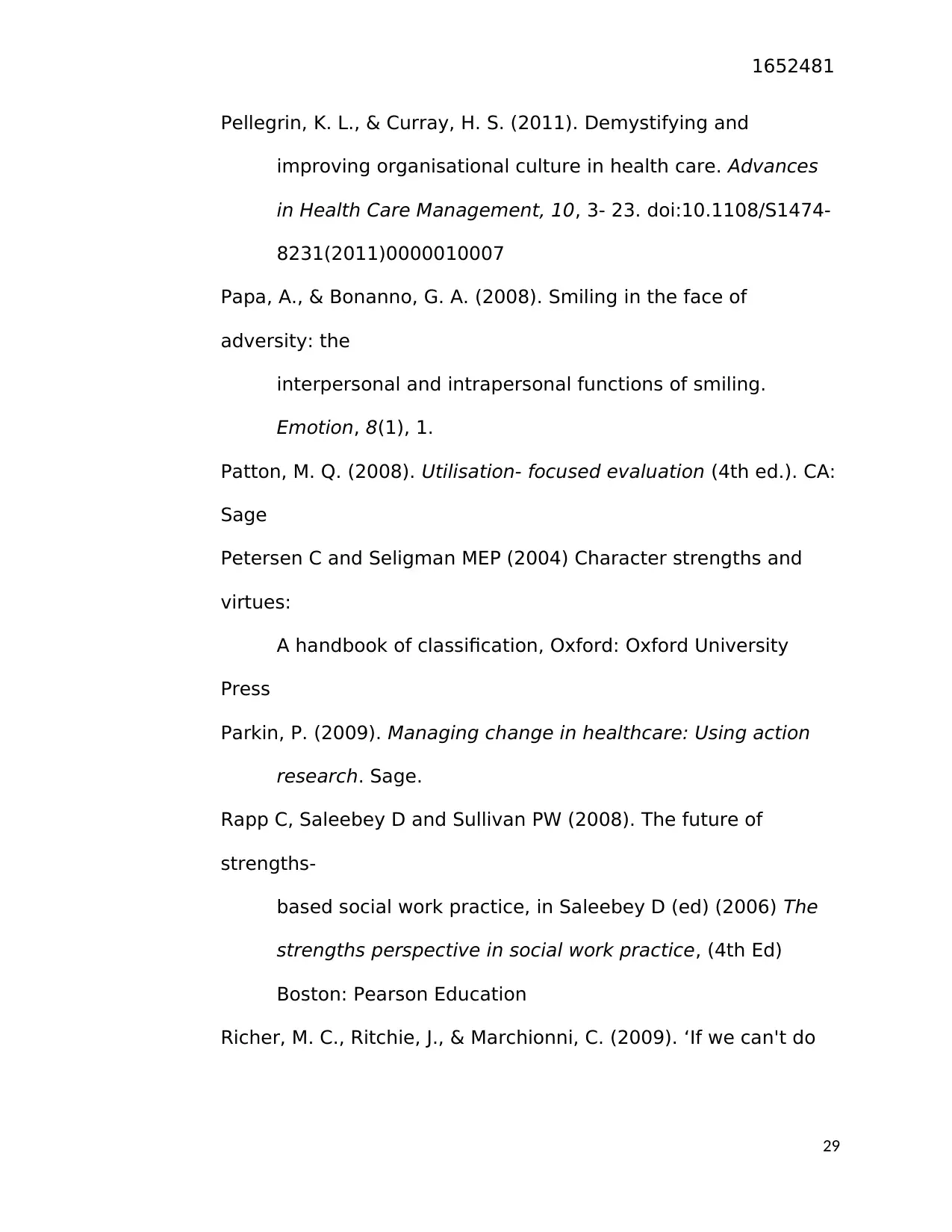
1652481
Pellegrin, K. L., & Curray, H. S. (2011). Demystifying and
improving organisational culture in health care. Advances
in Health Care Management, 10, 3- 23. doi:10.1108/S1474-
8231(2011)0000010007
Papa, A., & Bonanno, G. A. (2008). Smiling in the face of
adversity: the
interpersonal and intrapersonal functions of smiling.
Emotion, 8(1), 1.
Patton, M. Q. (2008). Utilisation- focused evaluation (4th ed.). CA:
Sage
Petersen C and Seligman MEP (2004) Character strengths and
virtues:
A handbook of classification, Oxford: Oxford University
Press
Parkin, P. (2009). Managing change in healthcare: Using action
research. Sage.
Rapp C, Saleebey D and Sullivan PW (2008). The future of
strengths-
based social work practice, in Saleebey D (ed) (2006) The
strengths perspective in social work practice, (4th Ed)
Boston: Pearson Education
Richer, M. C., Ritchie, J., & Marchionni, C. (2009). ‘If we can't do
29
Pellegrin, K. L., & Curray, H. S. (2011). Demystifying and
improving organisational culture in health care. Advances
in Health Care Management, 10, 3- 23. doi:10.1108/S1474-
8231(2011)0000010007
Papa, A., & Bonanno, G. A. (2008). Smiling in the face of
adversity: the
interpersonal and intrapersonal functions of smiling.
Emotion, 8(1), 1.
Patton, M. Q. (2008). Utilisation- focused evaluation (4th ed.). CA:
Sage
Petersen C and Seligman MEP (2004) Character strengths and
virtues:
A handbook of classification, Oxford: Oxford University
Press
Parkin, P. (2009). Managing change in healthcare: Using action
research. Sage.
Rapp C, Saleebey D and Sullivan PW (2008). The future of
strengths-
based social work practice, in Saleebey D (ed) (2006) The
strengths perspective in social work practice, (4th Ed)
Boston: Pearson Education
Richer, M. C., Ritchie, J., & Marchionni, C. (2009). ‘If we can't do
29
1 out of 29
Related Documents
Your All-in-One AI-Powered Toolkit for Academic Success.
+13062052269
info@desklib.com
Available 24*7 on WhatsApp / Email
![[object Object]](/_next/static/media/star-bottom.7253800d.svg)
Unlock your academic potential
© 2024 | Zucol Services PVT LTD | All rights reserved.





